“Alastair,
I discovered an old photograph of a train that might inspire some of the model makers interested in historic train layouts.
Here’s the background. Before chainsaws were invented, the logging industry in the United States & Canada was a seriously challenging occupation. In the Pacific Northwest there were forests full of monster trees (Douglas Firs) and cutting them down was done by hand.
Even more amazing than the fact that these trees were cut down with two man hand saws (the vertical saw in the middle of the photograph) was the fact that somehow it was manual labor that loaded giant hunks of the trees onto flat cars (photo below).
Anyone out there want to create a layout like this?
John”
Thanks to John for sharing – but now there’s a question I can’t get out my head: how did they get the logs on the train?
“I have been busy since November building another small layout. I have hinted at the genesis but now the layout is complete and ready to share.
To repeat an earlier letter, this layout was primarily inspired by individuals who have been complaining that the cost of this hobby is getting to be too much. In response; i decided to see how thriftily I could build a layout. Thanks to your hints, your e-bay cheat sheet, and some very old magazines; I have built this layout for right around $200 USD including trains, track, baseboard, power supply, and scenery.
Superior Detritus…..
From about 1952 to 1972, John Allen was one of the best known and most influential model railroaders in the United States. In 1955, he wrote an article for Model Railroader magazine that focused on weathering models to improve realism. One of the examples in the article was a little wooden boxcar lettered for the Superior Detritus Company. John Allen is also known for having dreamed up the well known Timesaver switching puzzle. Although John Allen passed away in 1972, his name and influence have lived on. While this layout began as an exercise in thriftiness, the concept grew into an homage to the modelers of the 1950’s and 1960’s with only the track as an anachronism.
In California, everything is now taxed and usually with a surcharge or two added in. Lumber is one of those items that the state surcharges. To establish the principle of thrifty modeling, the baseboard and integral backdrop for this layout were made from salvaged cardboard. I also used salvaged cardboard for the roadbed under the track. PVA glue is a wonder. Gesso and spackle helped a lot also. The baseboard is about 12 inches by about 50 inches; it was assembled in about 2 weeks or about 10 hours. When one includes track (recycled but worth about $40 if purchased new) and rough scenery, I was ready to run trains in about 3 weeks or 15 hours. One reason I used the cardboard for roadbed was that cork would have set me back about $20.00 USD.
Three weeks after starting, this is what the railroad looked like… (Part 1 of Superior Detritus)
As you can see from part 1, Superior Detritus uses the familiar Inglenook Sidings plan and to be exact, the Little Bezely varient from Andrew Wyman’s site.
I have found the Inglenook Sidings idea to be a truly elegant solution to having an interesting layout when one is short on funds and short on time. Operating an Inglenook Sidings layout holds interest, takes up tittle space, and the two switches are relatively easy on the wallet also. The track layout is relatively common on real railroads and found in many industrial areas The lack of a passing loop (runaround) does not hinder operations in the least. For Superior Detritus, the main spur has a 3 or 4 car capacity with the other two sidings having 2 car capacities each. Operation of Superior Detritus takes one locomotive and 5 or six freight cars. Careful shopping on e-bay provides all the necessary equipment and a power supply for less than $100 USD as of January 2014.
The main destination for Superior Detritus is the processing and packaging plant for all the fine products they offer. The design provides a new twist to the classic operation of Inglenook Sidings; there are now specific “spots” or locations for the cars not being used in the “outbound train.” The plant was constructed primarily from mat board with some balsa and spruce thrown in for good measure. Building this structure took me the batter part of a month to get it all “blocked in”…
With the basic plan in place and the structure for Superior Detritus “blocked in”, painting and detailing were begun. During this process there were a few missteps as some items I thought about adding did not exactly fit in as planned. Part of the problem is that I was trying to avoid styrene (just a little challenge I added to keep things “vintage”) and Northeastern wood products and shapes are not found at many local American hobby shops anymore. Some detail strips were made from cardboard salvaged from a cereal carton while others were scribed on salvaged business cards. Also a couple of oil storage tanks were made from a couple of toilet paper roll cores.
I started the Superior Detritus project on November 18 and “finished” the project on January 21. As I have shared before, time is a challenge for me and I believe I averaged about 5 hours of work on this project every week for the two months and change I spent building this layout
The closer I got to “finishing” this project, the more I notices specific details that became annoying. One of those details was the blatant visibility of the “switch motors” on the Atlas turnouts I used. I generally prefer Peco track but the two Atlas switches were handy and I could not beat the price… “free” out of my spare track box…. This was one detail that had to get dealt with for my sanity. The biggest hurdle in hiding the “machines” was that one of my switches had a “powered” switch motor while the other was manual.
Another detail concerned the trees on the layout. The trees are all “scratch built” in the 1950’s style (I will offer a primer soon). They were made with wire armatures, spackle, gesso, and Woodland Scenics foliage (another anachronism). In planning this layout, before I decided to “go retro”, I noticed that the beautiful, assembled Woodland Scenics trees were $20.00 for three. While they offer some “cost saving” kits for trees, my trees set me back about $25 or $30 for the dozen that are on the layout.
The last detail is people. I did not want to model an abandoned factory. fortunately I found three figures I had left over from some other project.
Here are some final photos of my layout. Two are shown to reinforce the advantages of a small layout. The first is the layout the now infamous ironing board. The ironing board began when I read in Railroad Modeller about Ironton Sidings and how its builder presents his layout at shows over on your side “of the pond”. Observing that presentation offered an opportunity to show that a reasonable layout does not need to take up a basement or an attic. The second has the layout standing on end to show it could be stored in a corner of a room, a garage, or a closet. Again an advantage for those challenged with too little space for a “permanent” layout.
Weathering the buildings and a few other small details have helped me finish the layout. It now appears more like a functioning railroad with a purpose. I hope you have enjoyed my little saga in pictures…
Sincerely,
John Reynolds”
Wow! Big thanks to John – really enjoyed that.
Please do keep ’em coming – whatever you’re building. Or even if you’ve just made a start.
And if today is the day you grab the bull by the horns, the Beginner’s Guide is here.
Best
Al
PS Latest ebay cheat sheet is here.



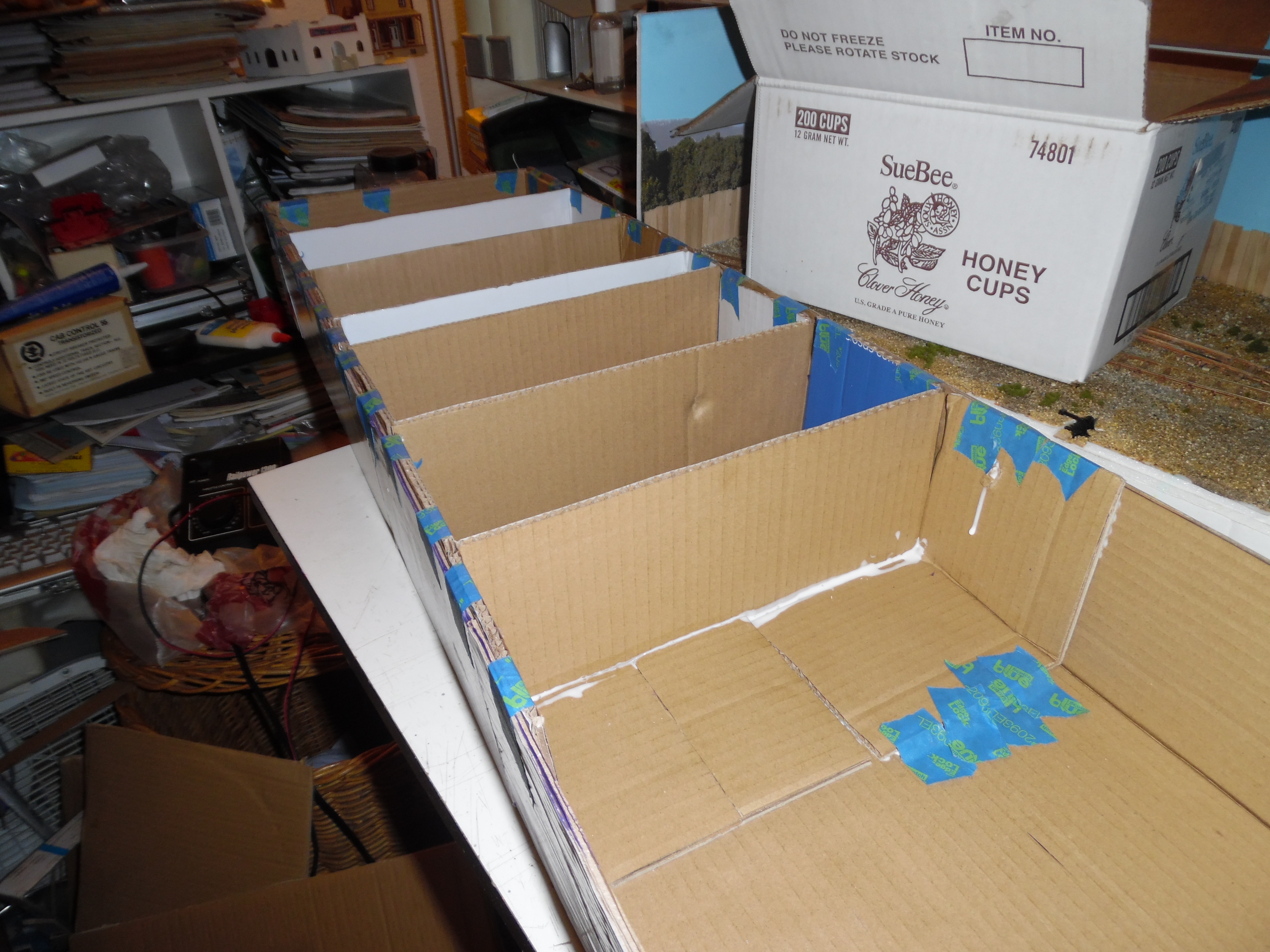
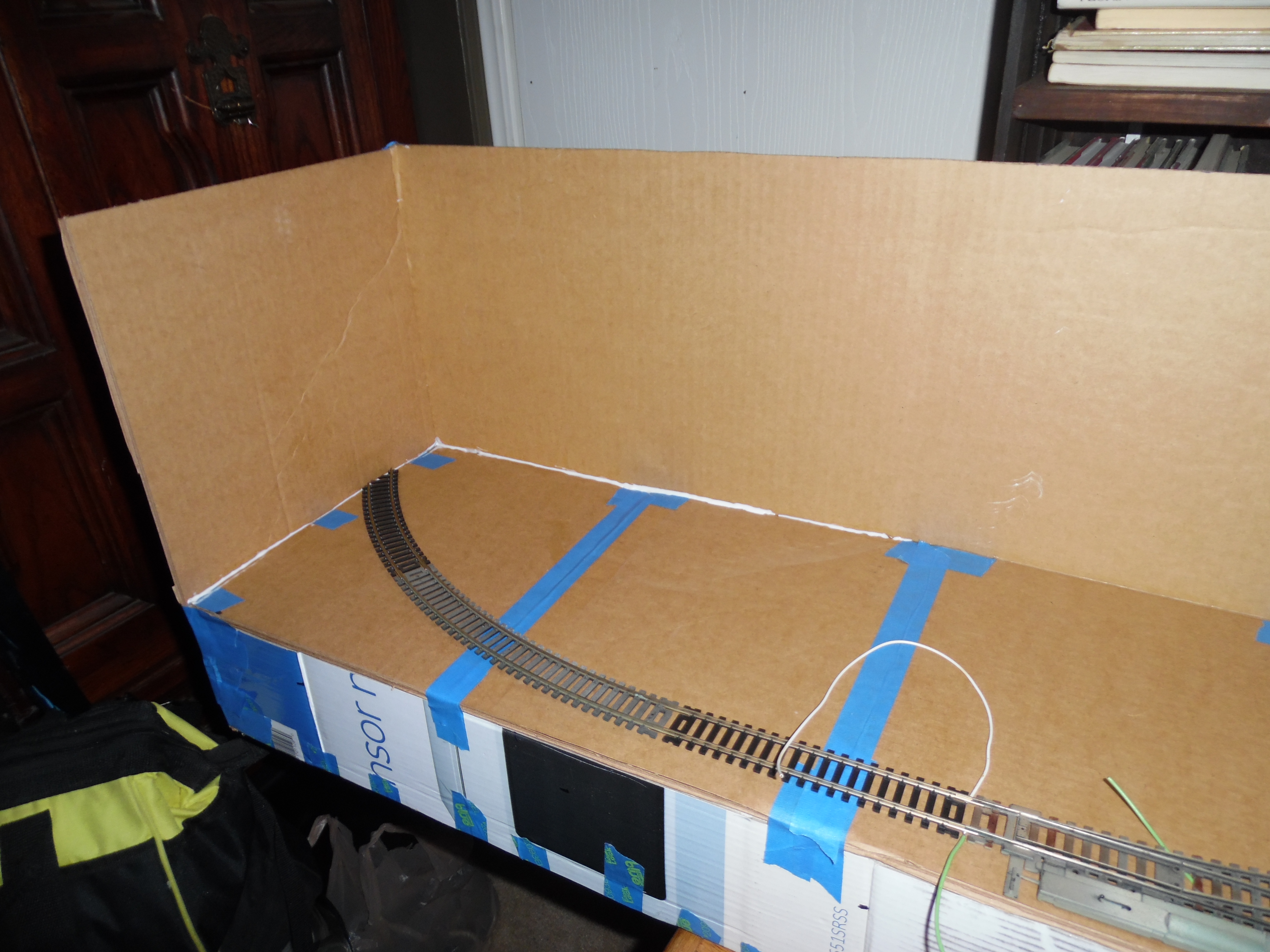
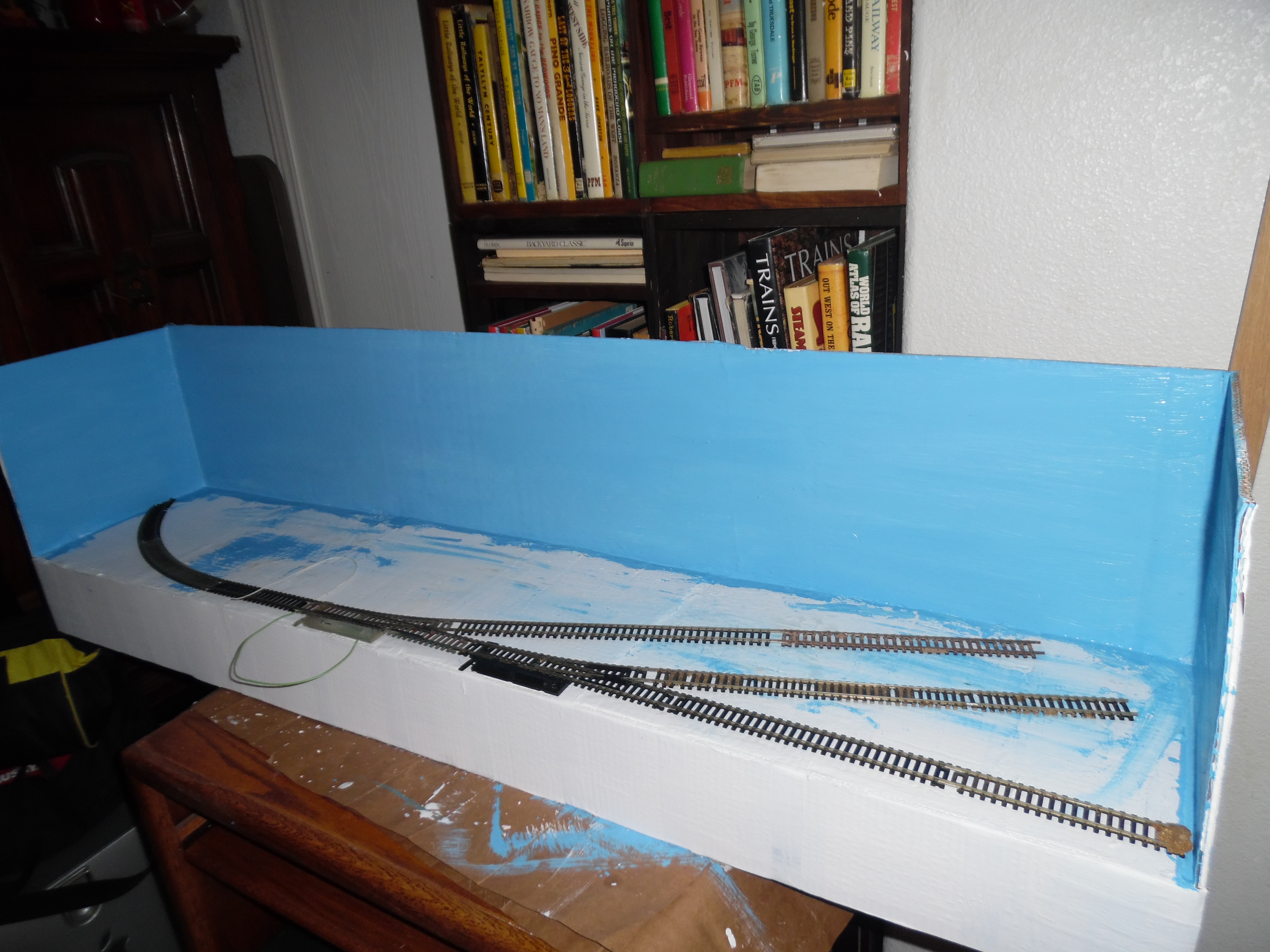
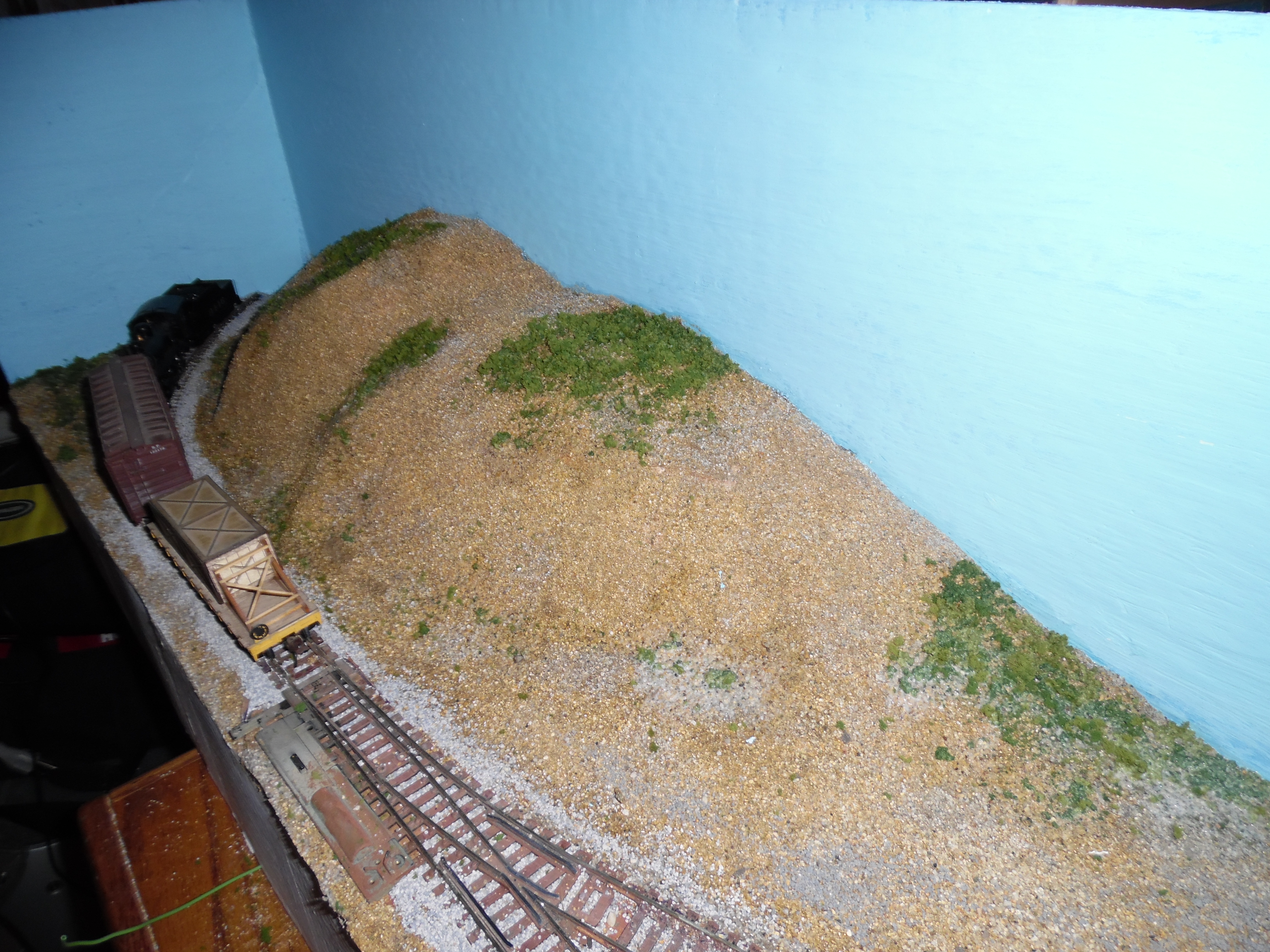
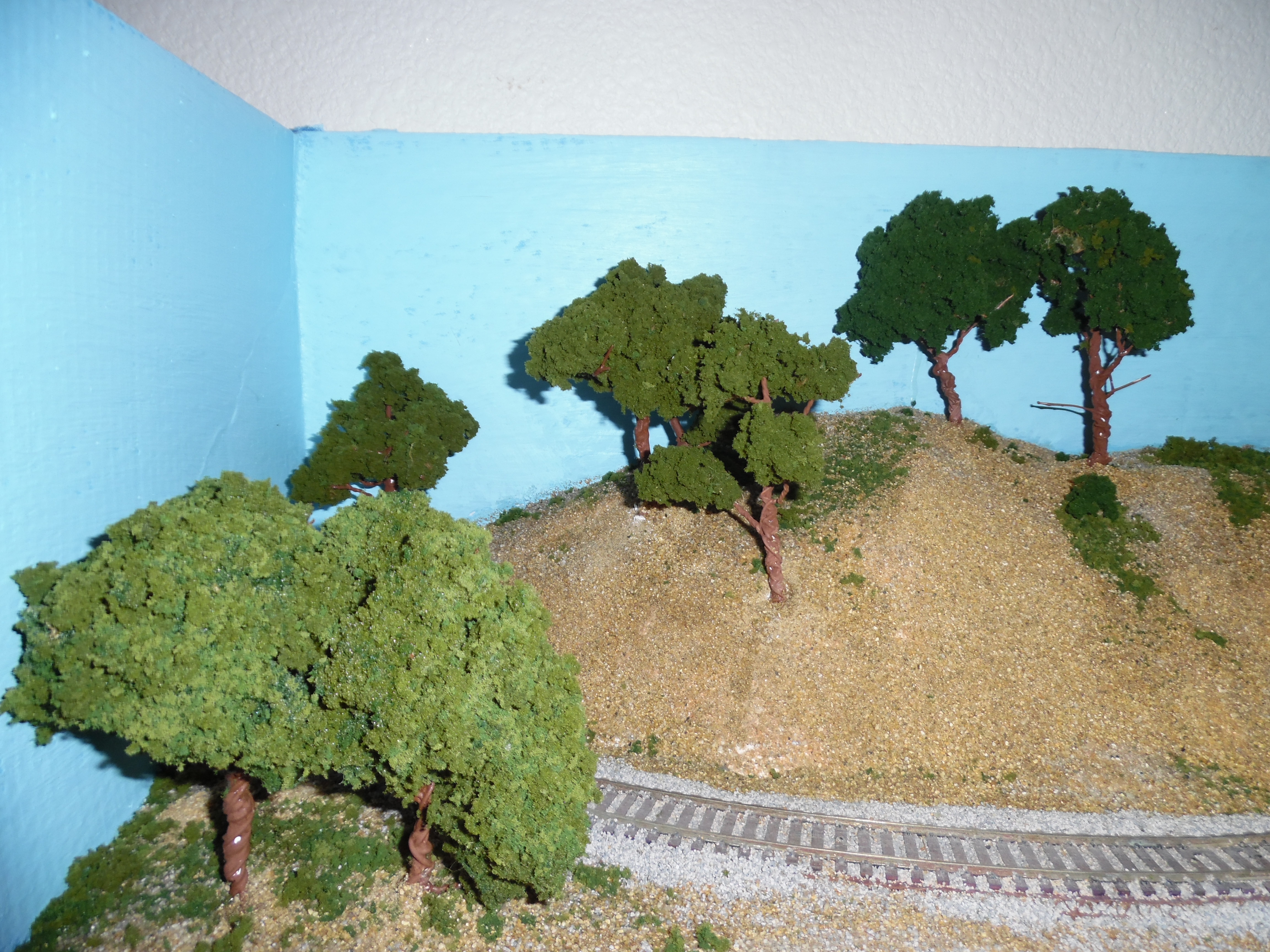
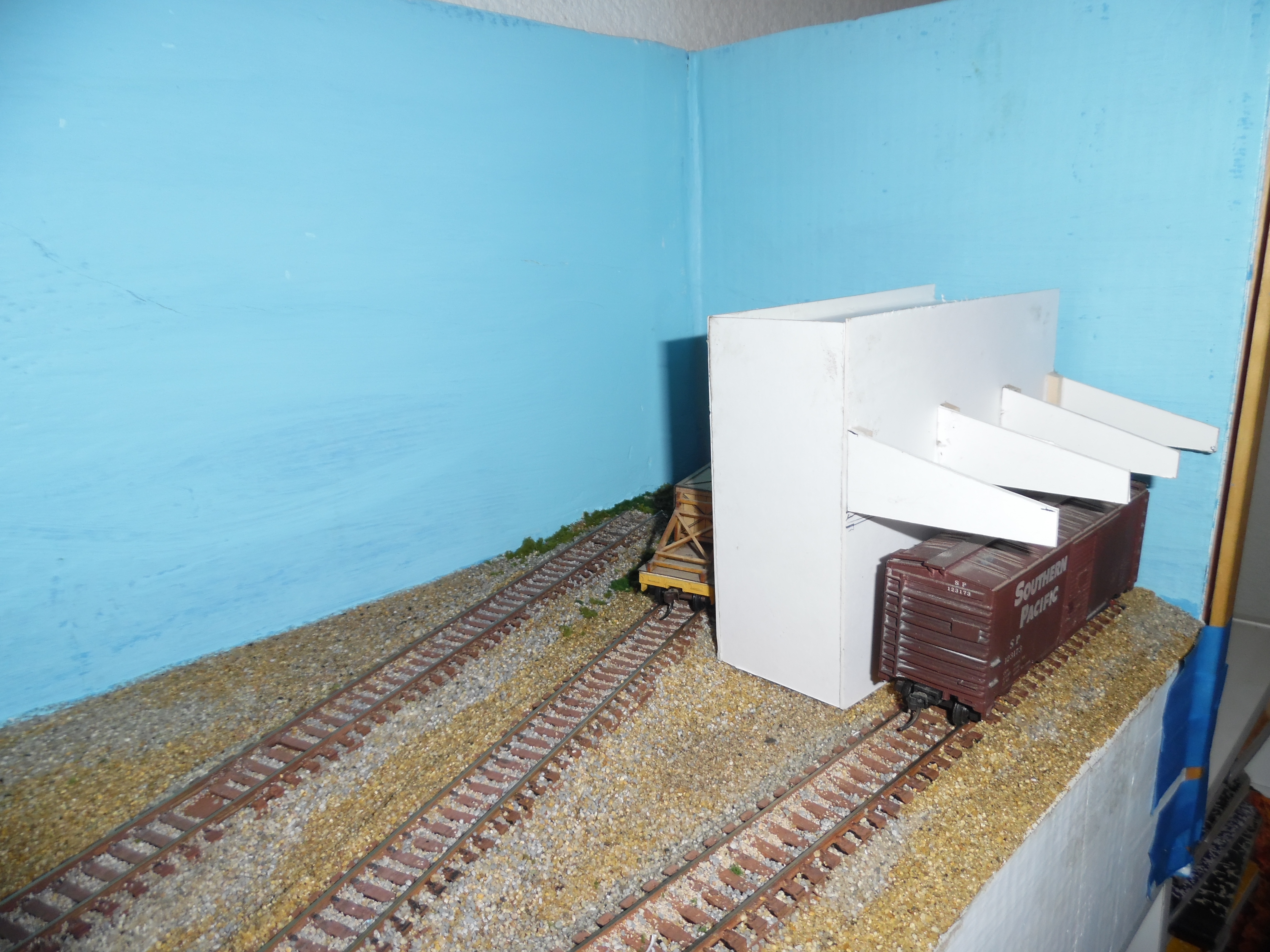
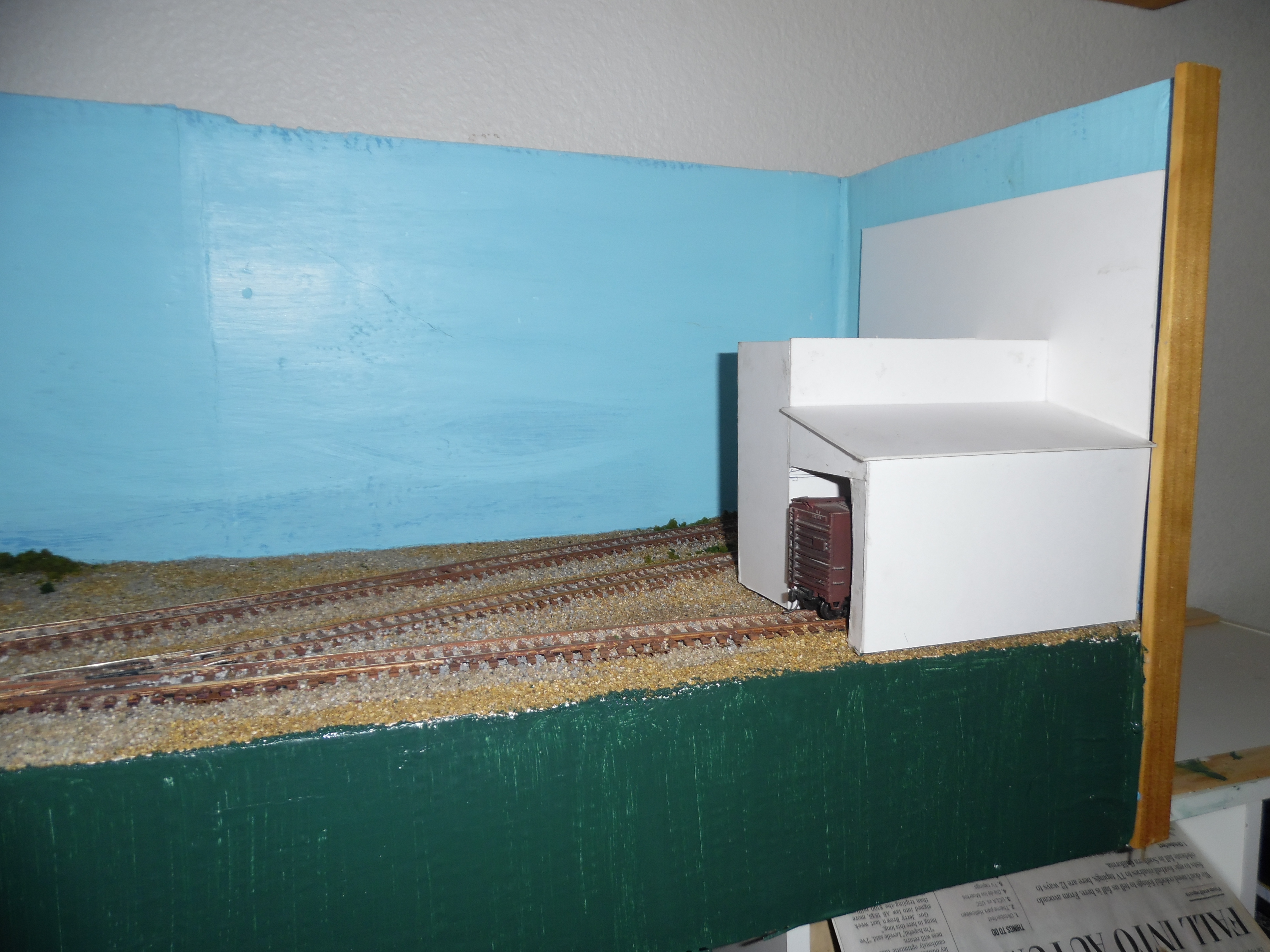
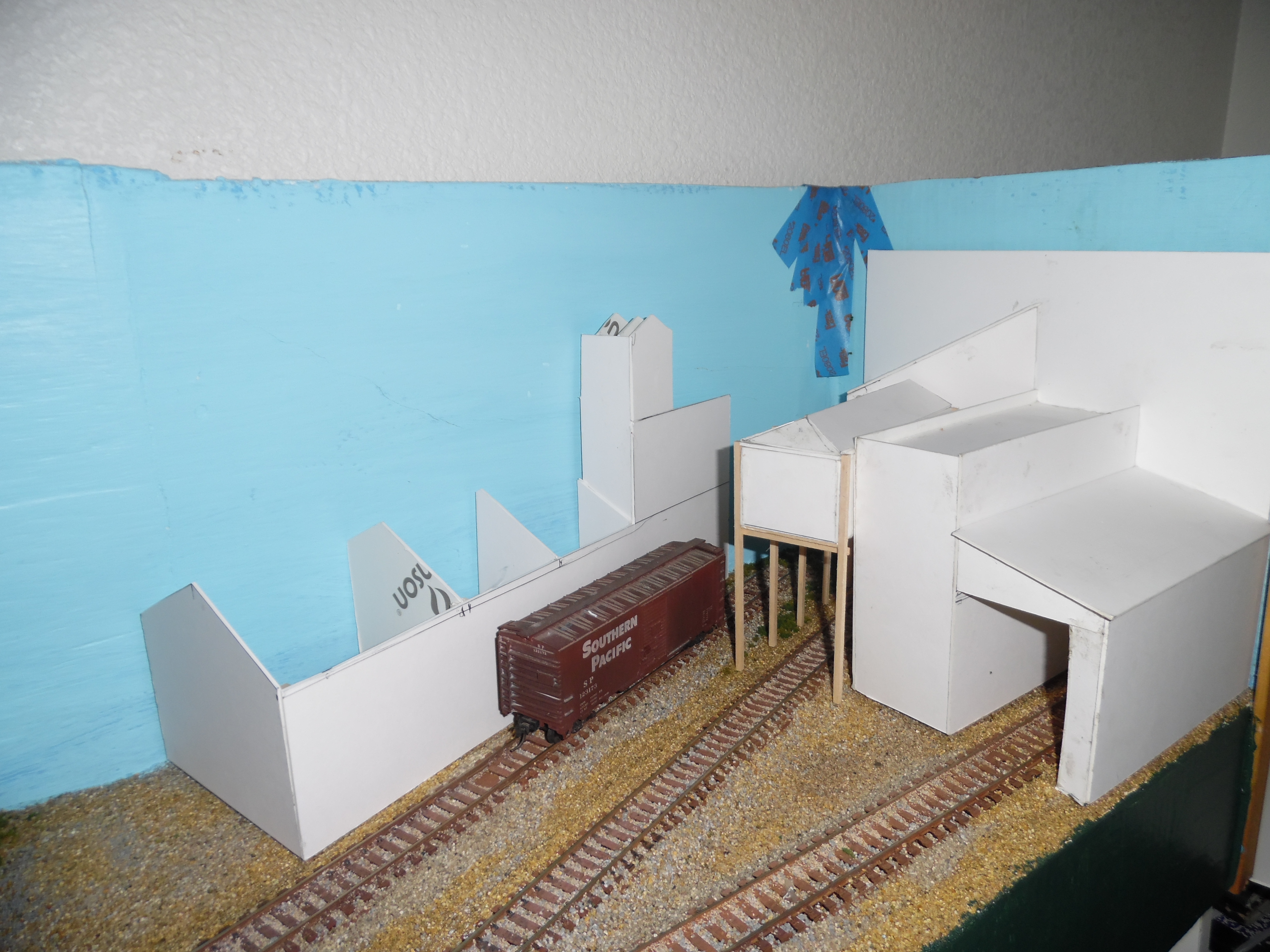
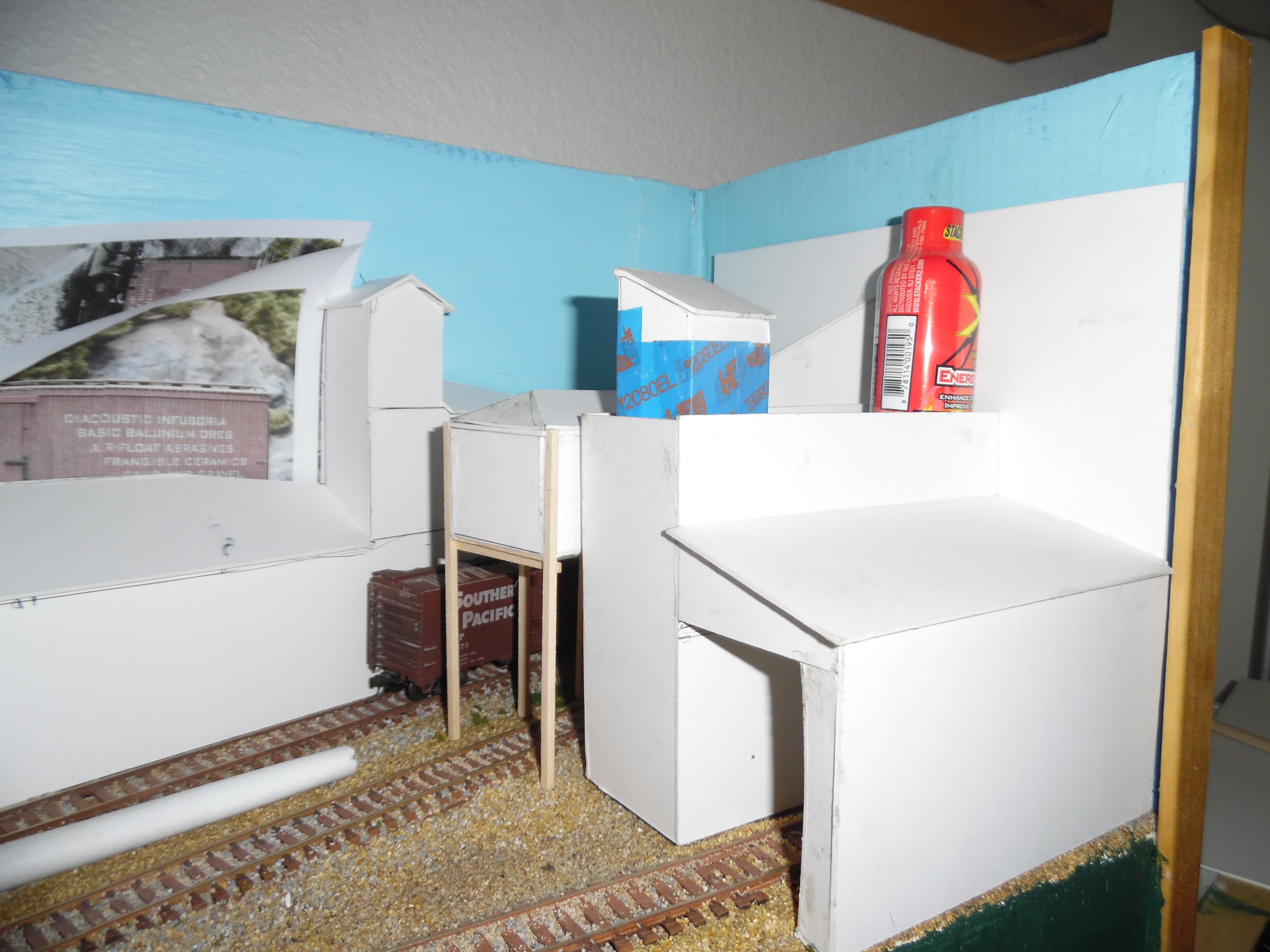
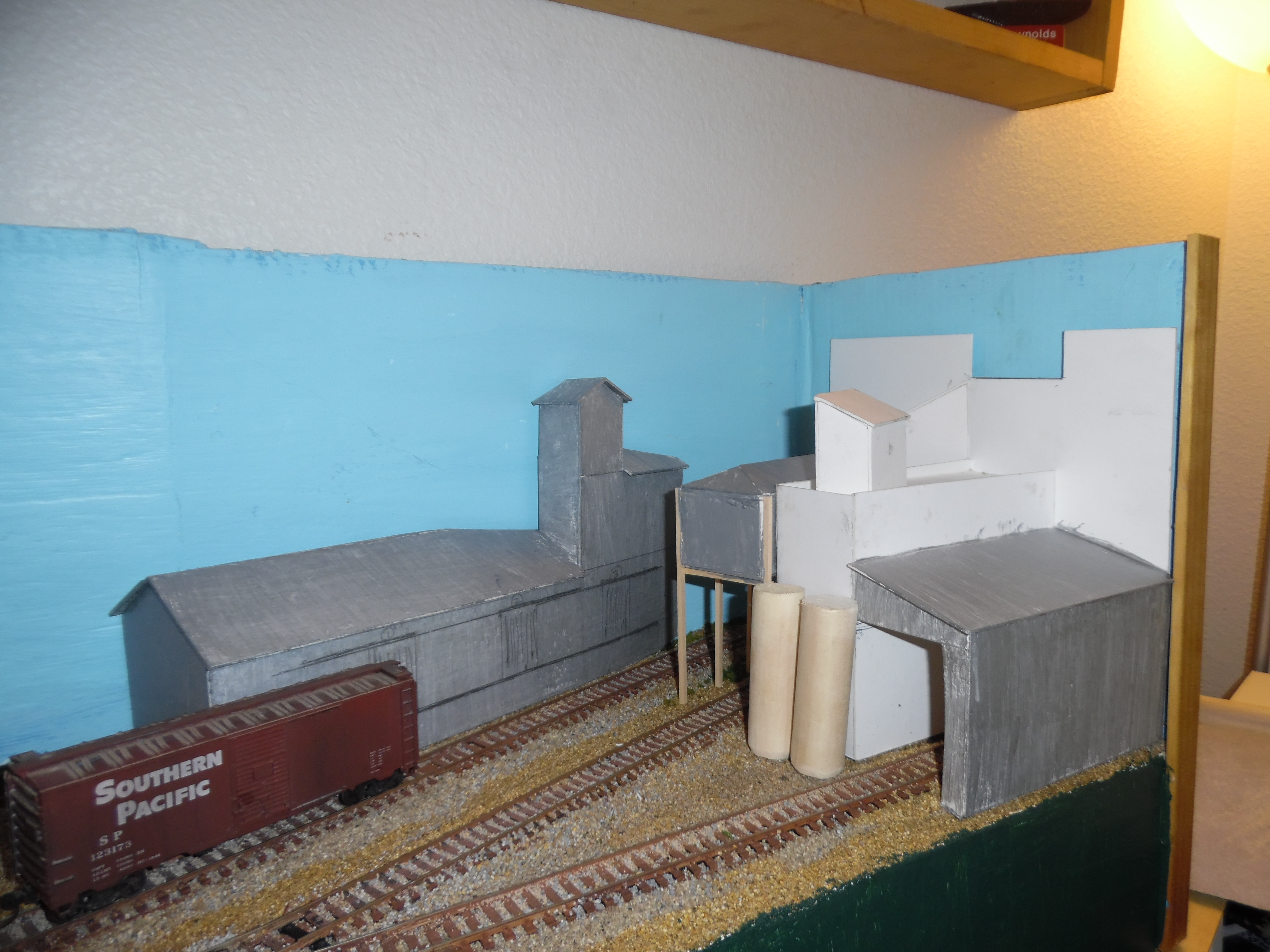
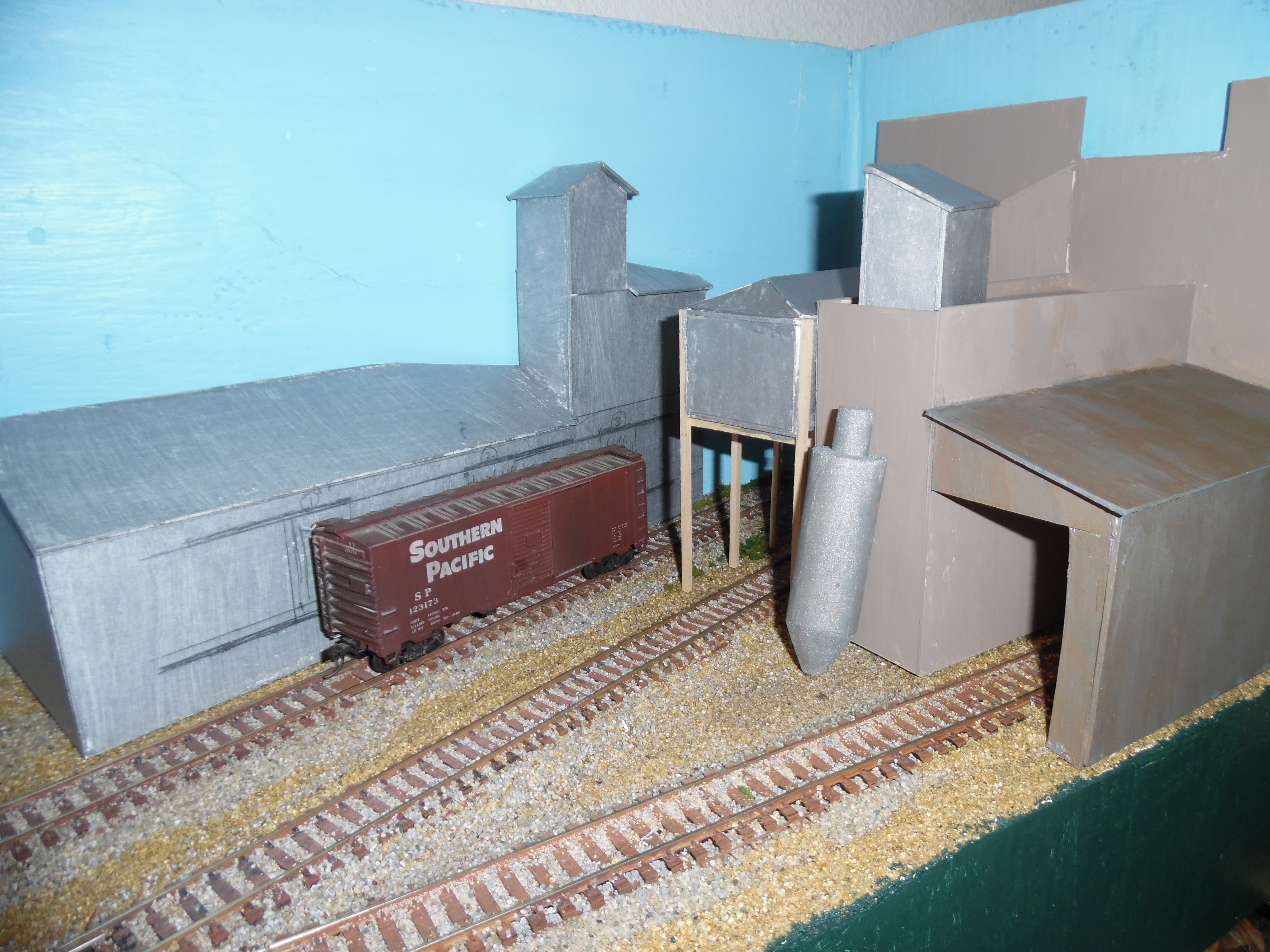
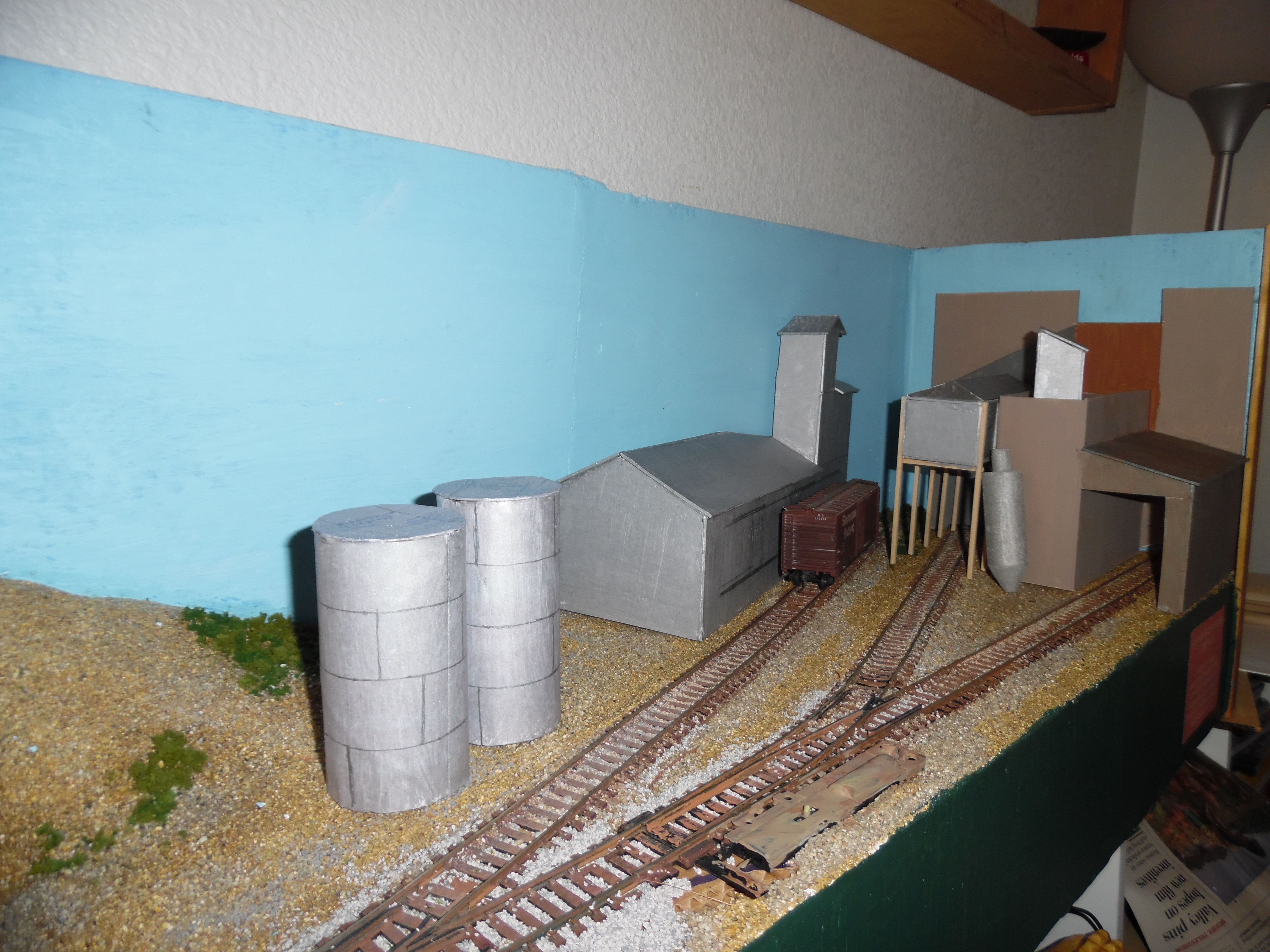
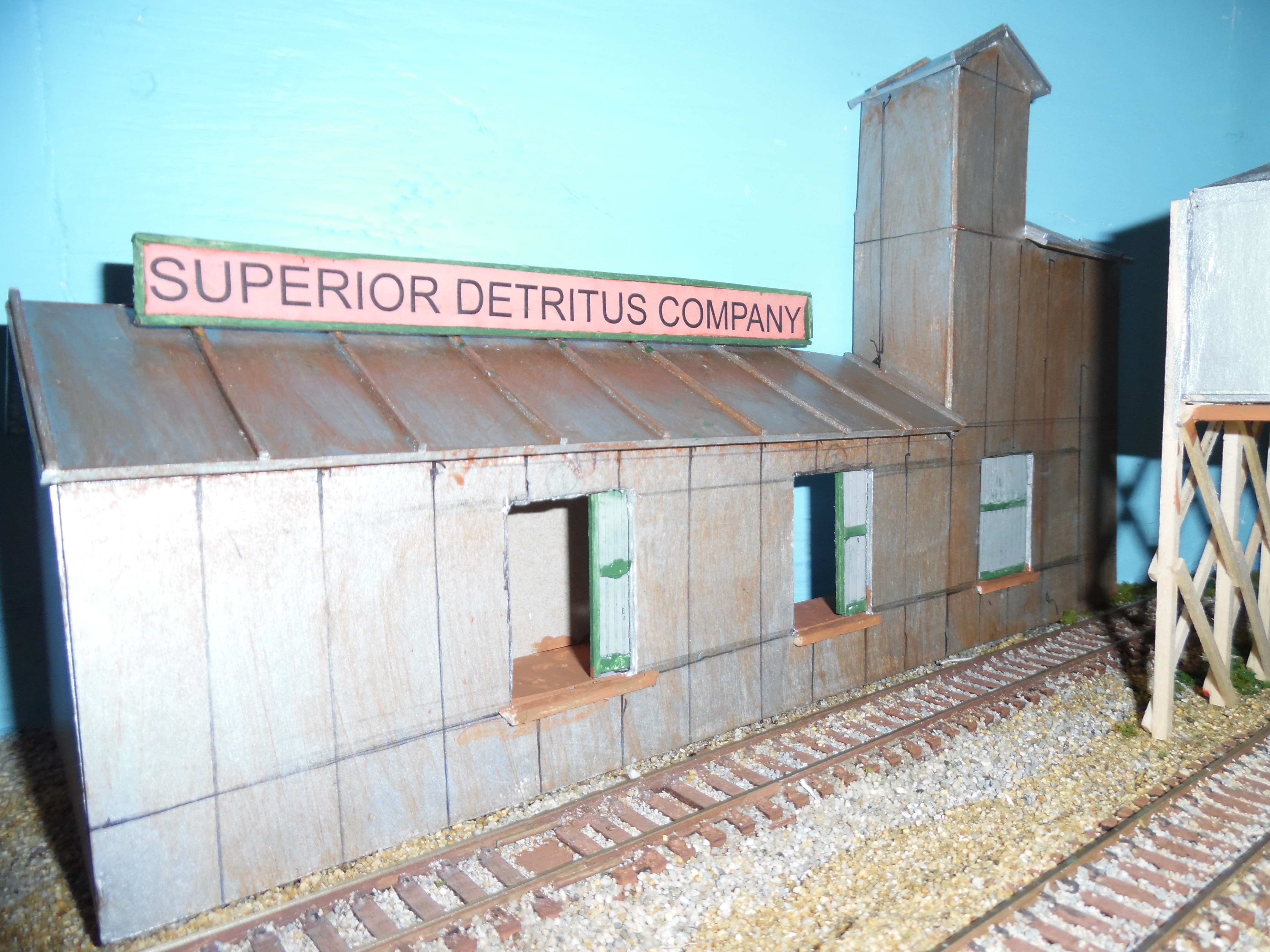
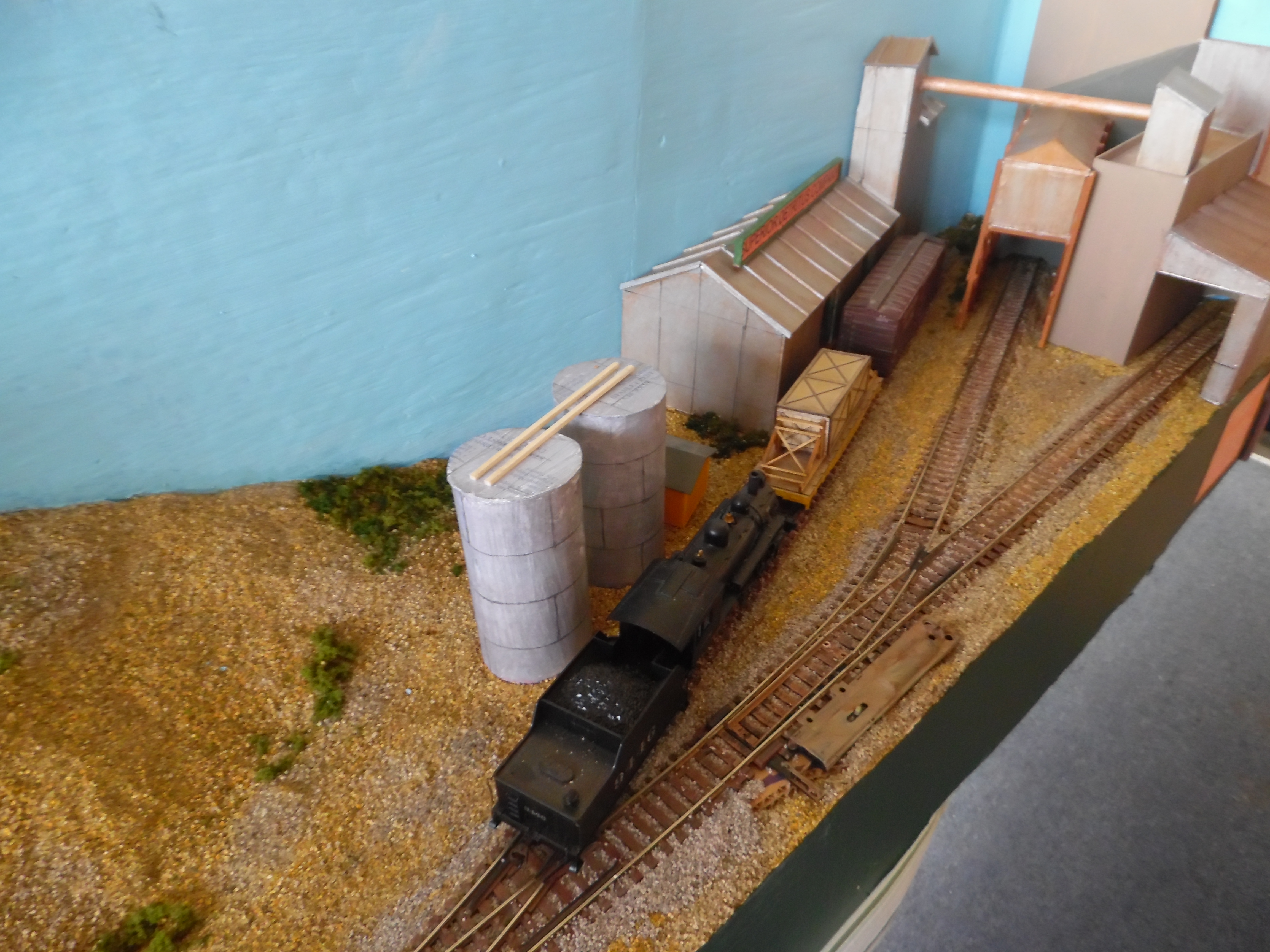
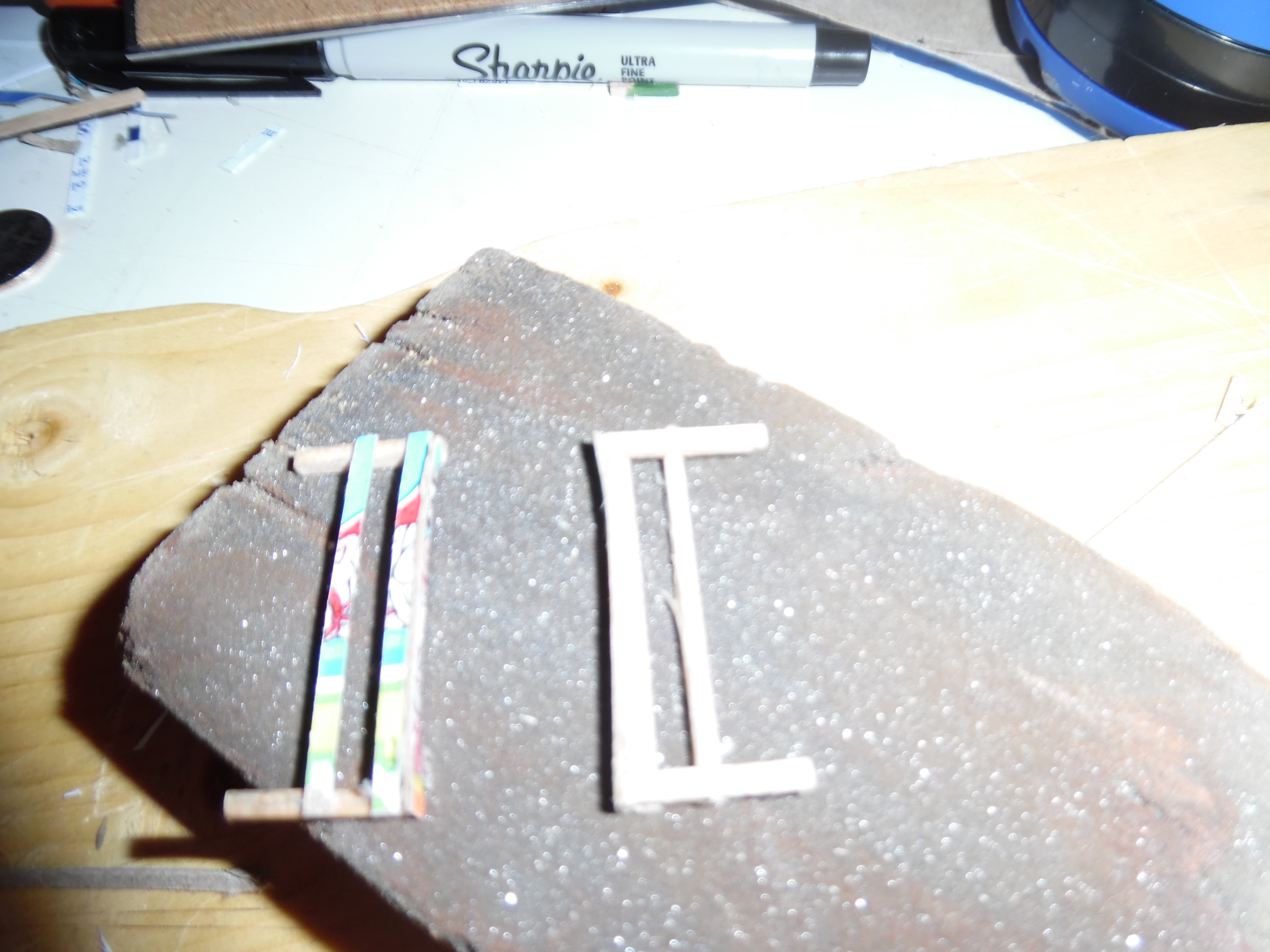
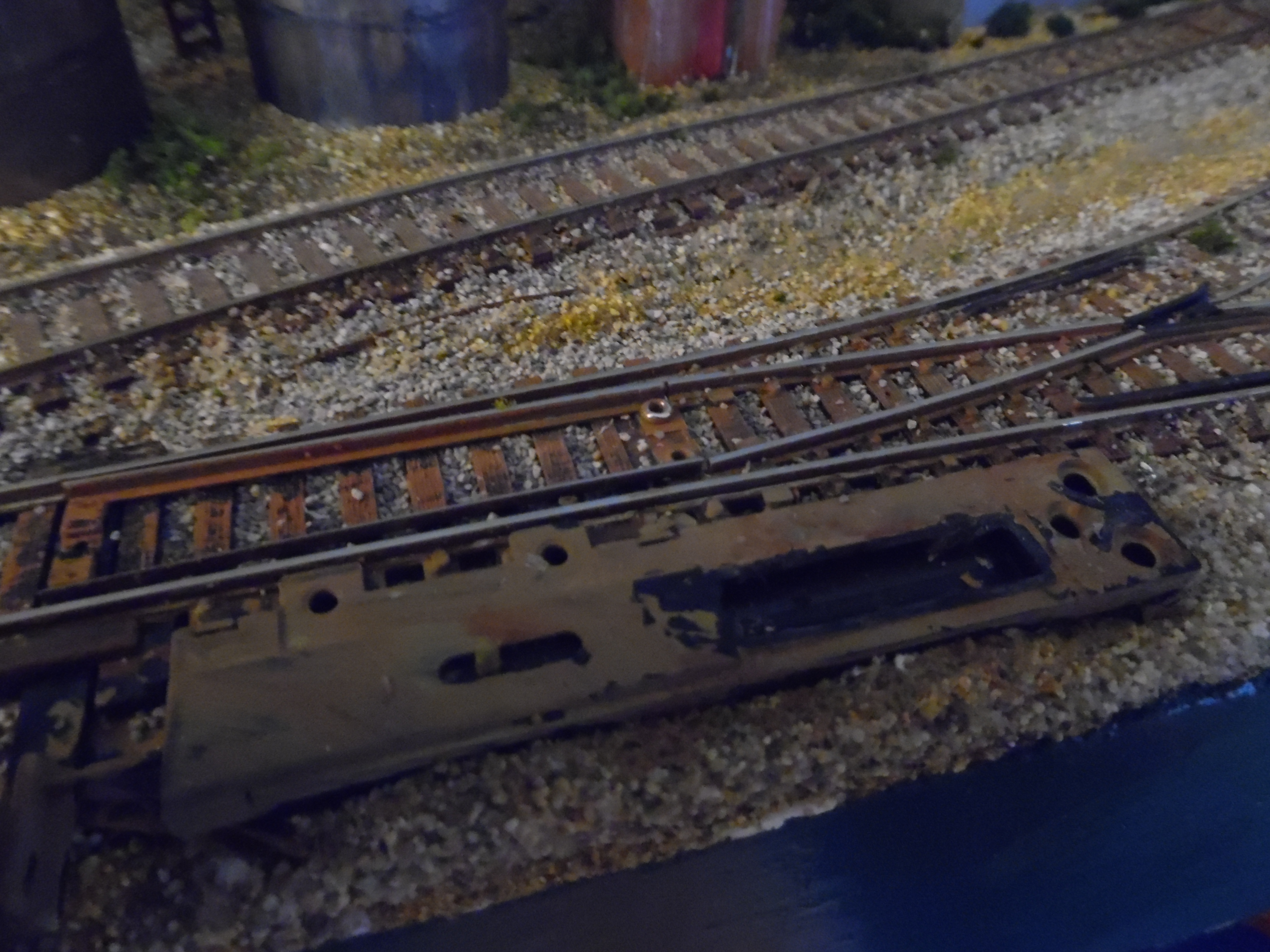
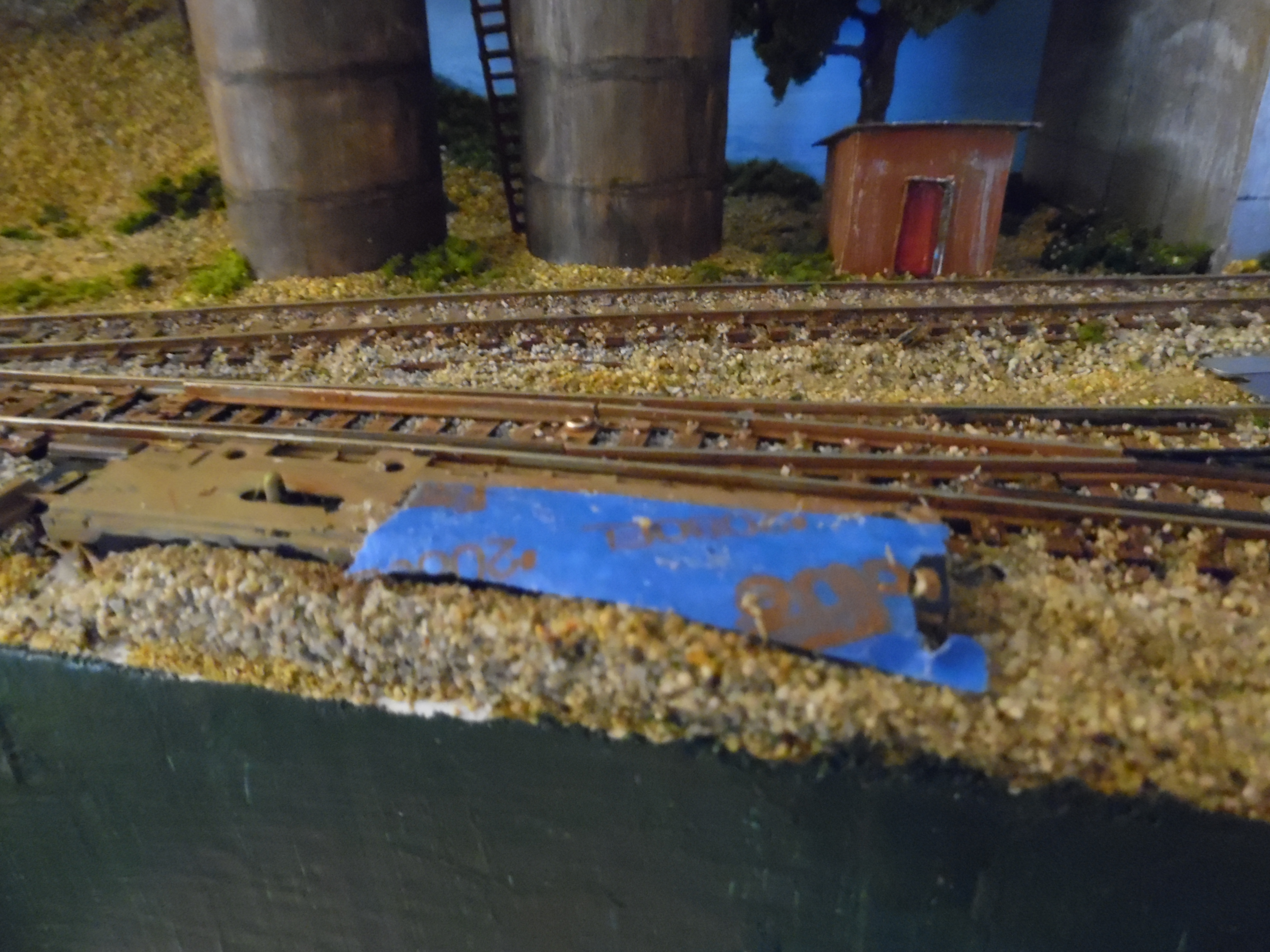
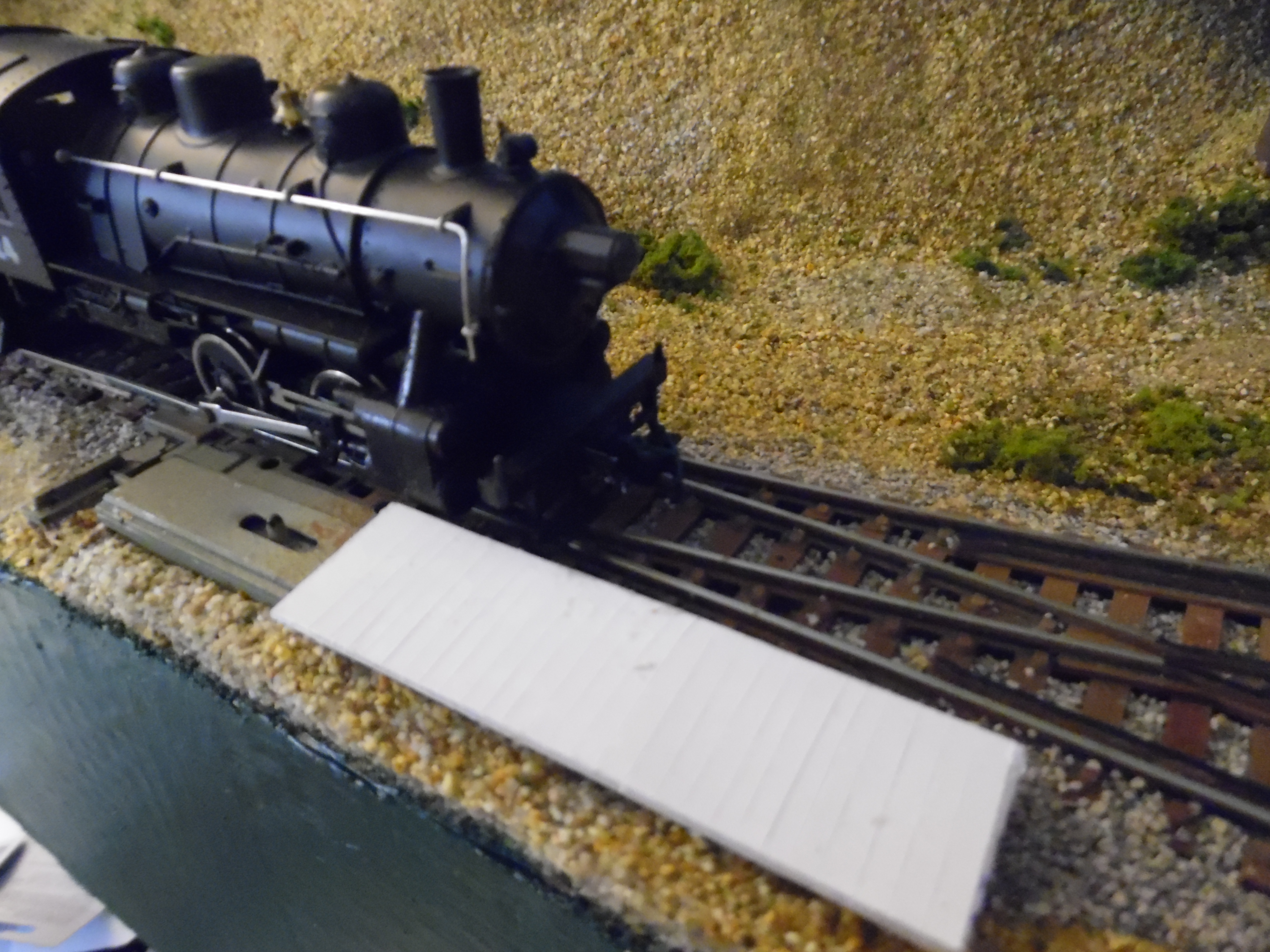
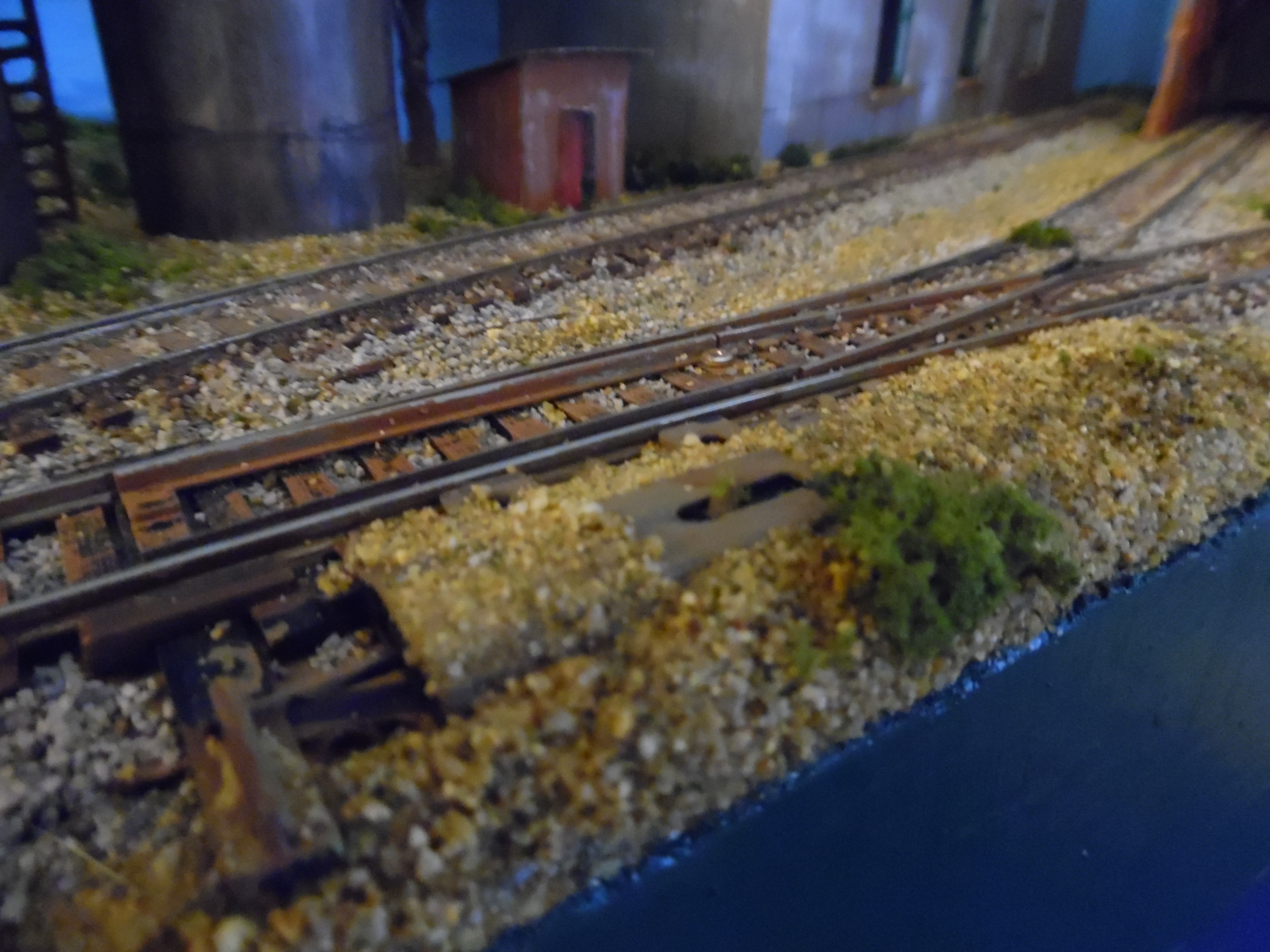
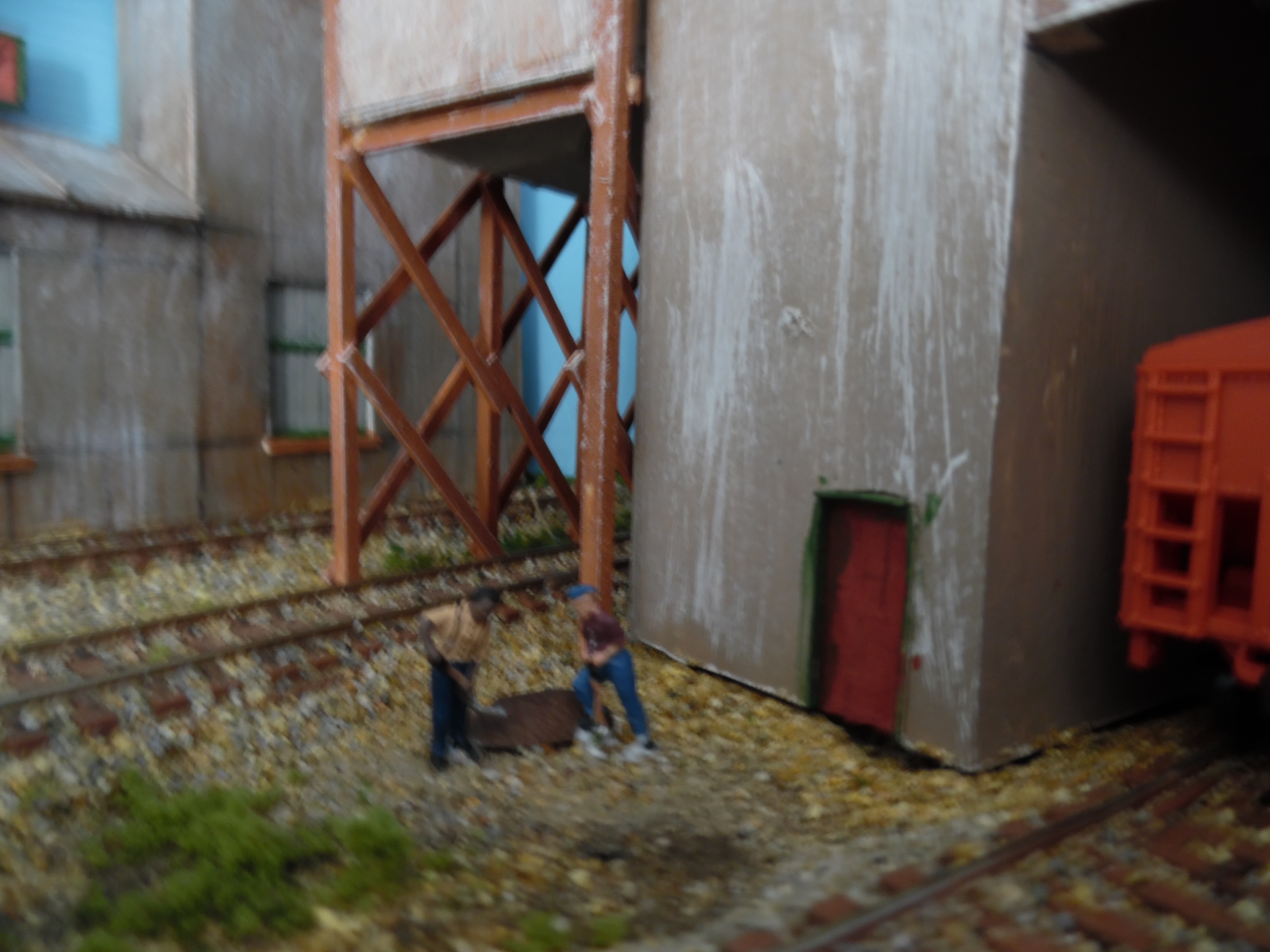
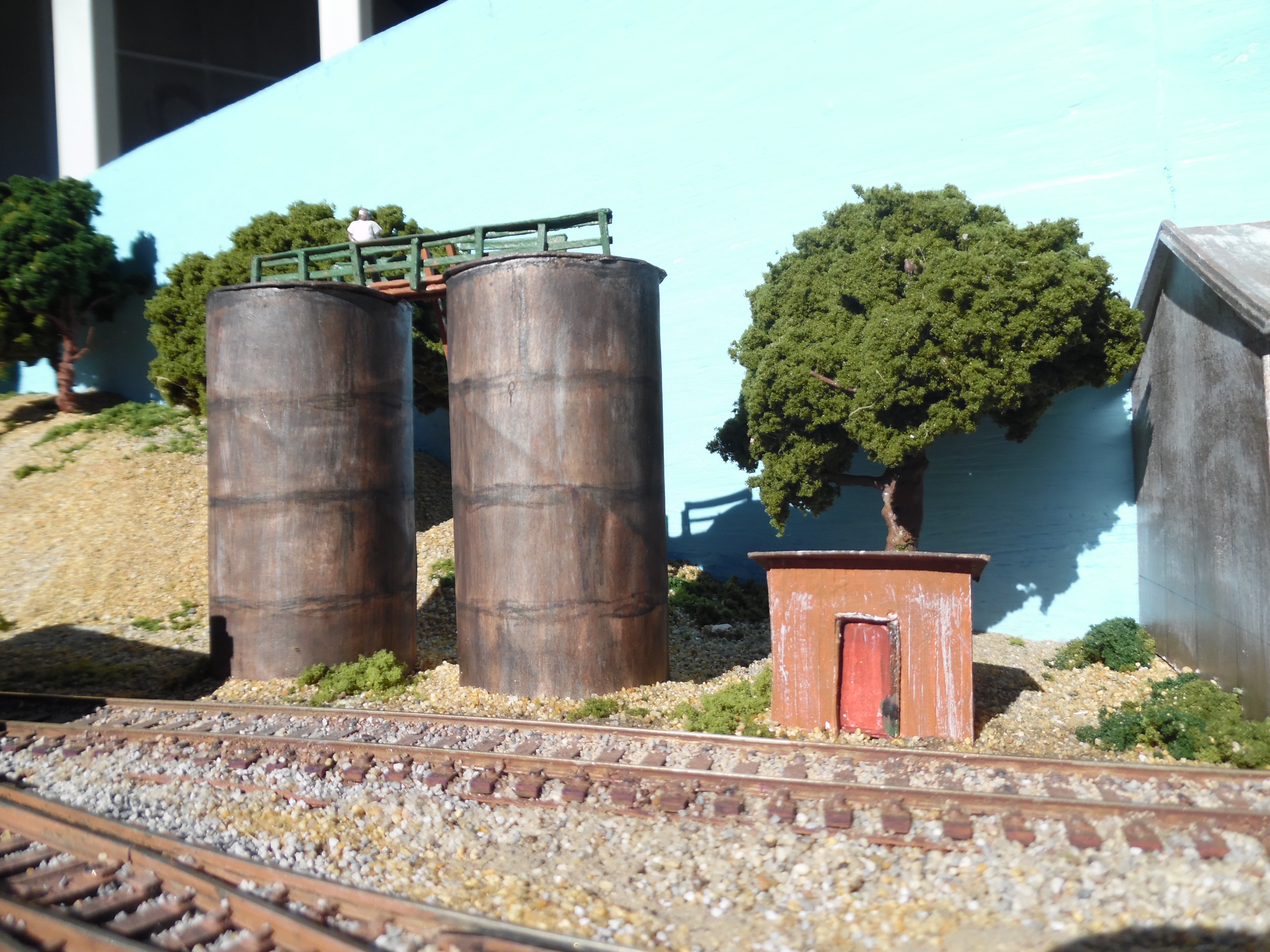
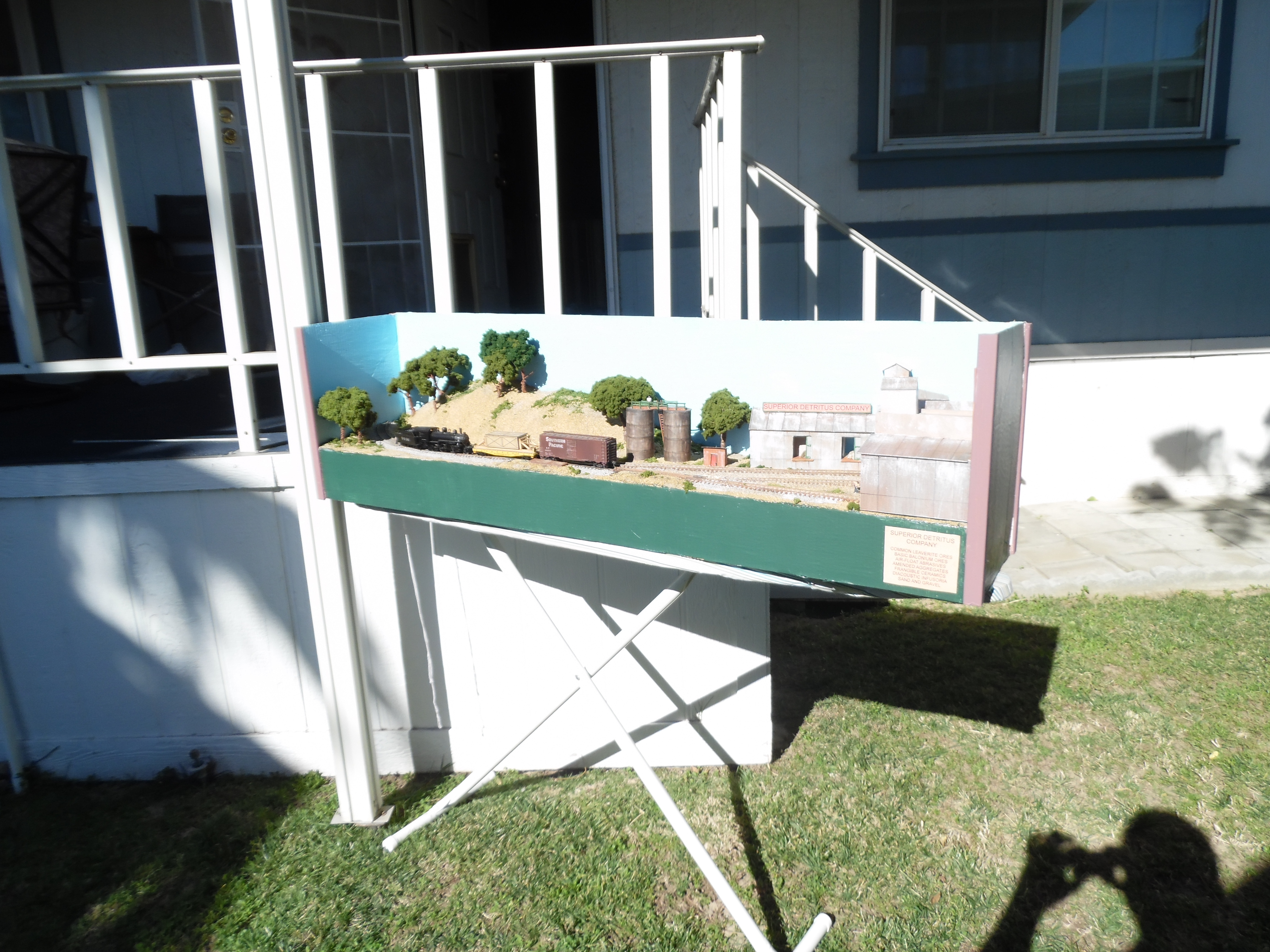
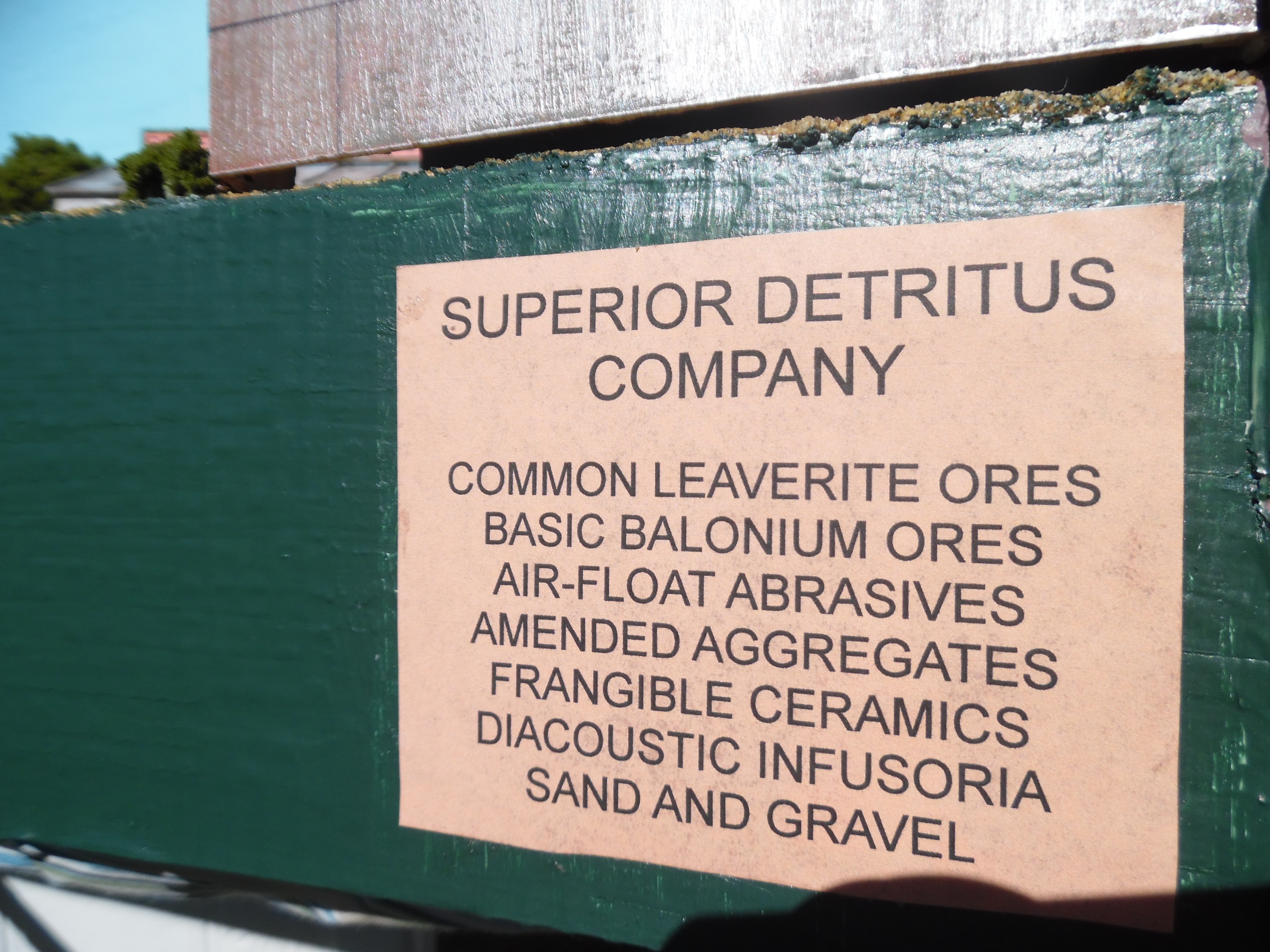
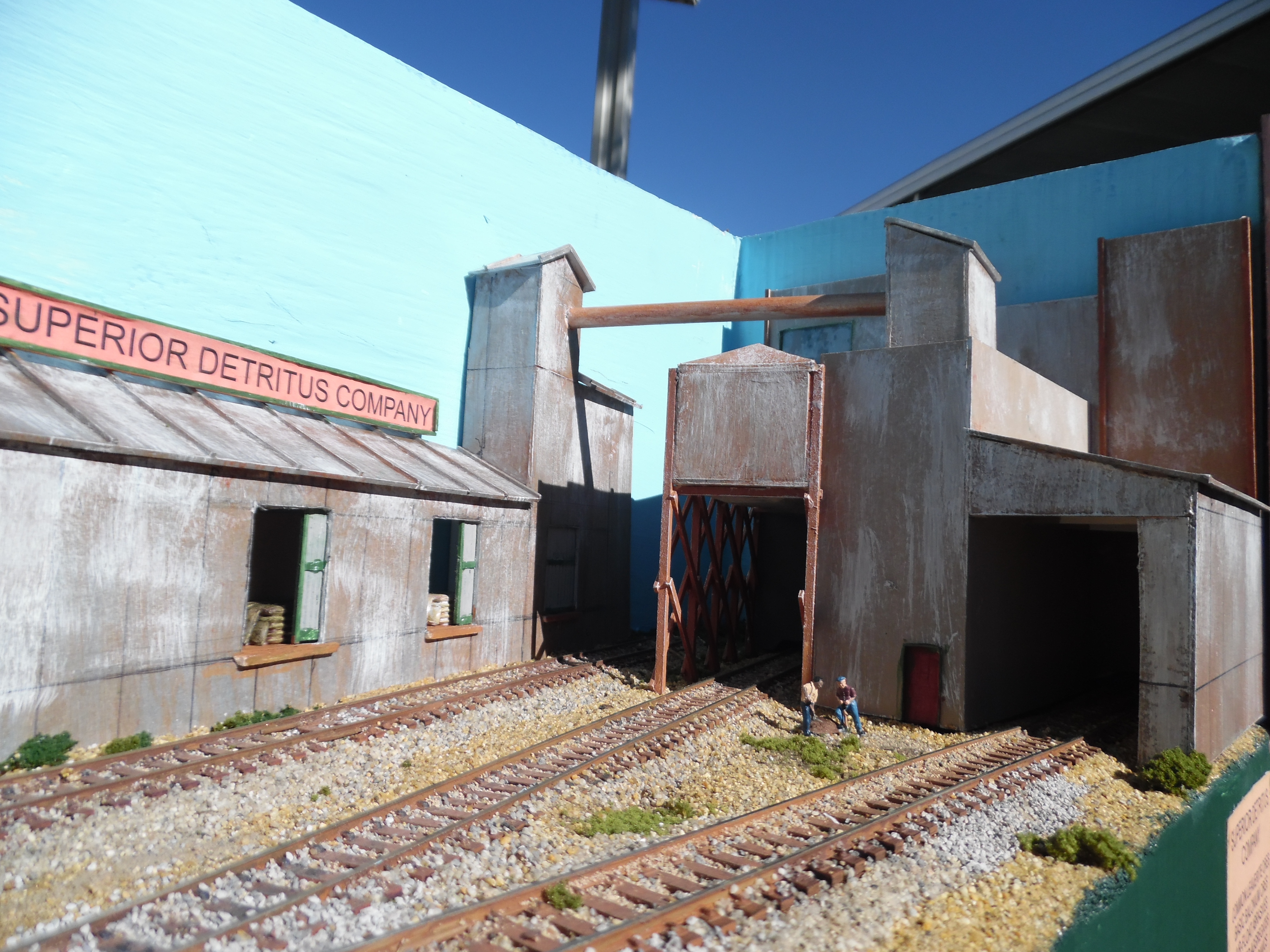
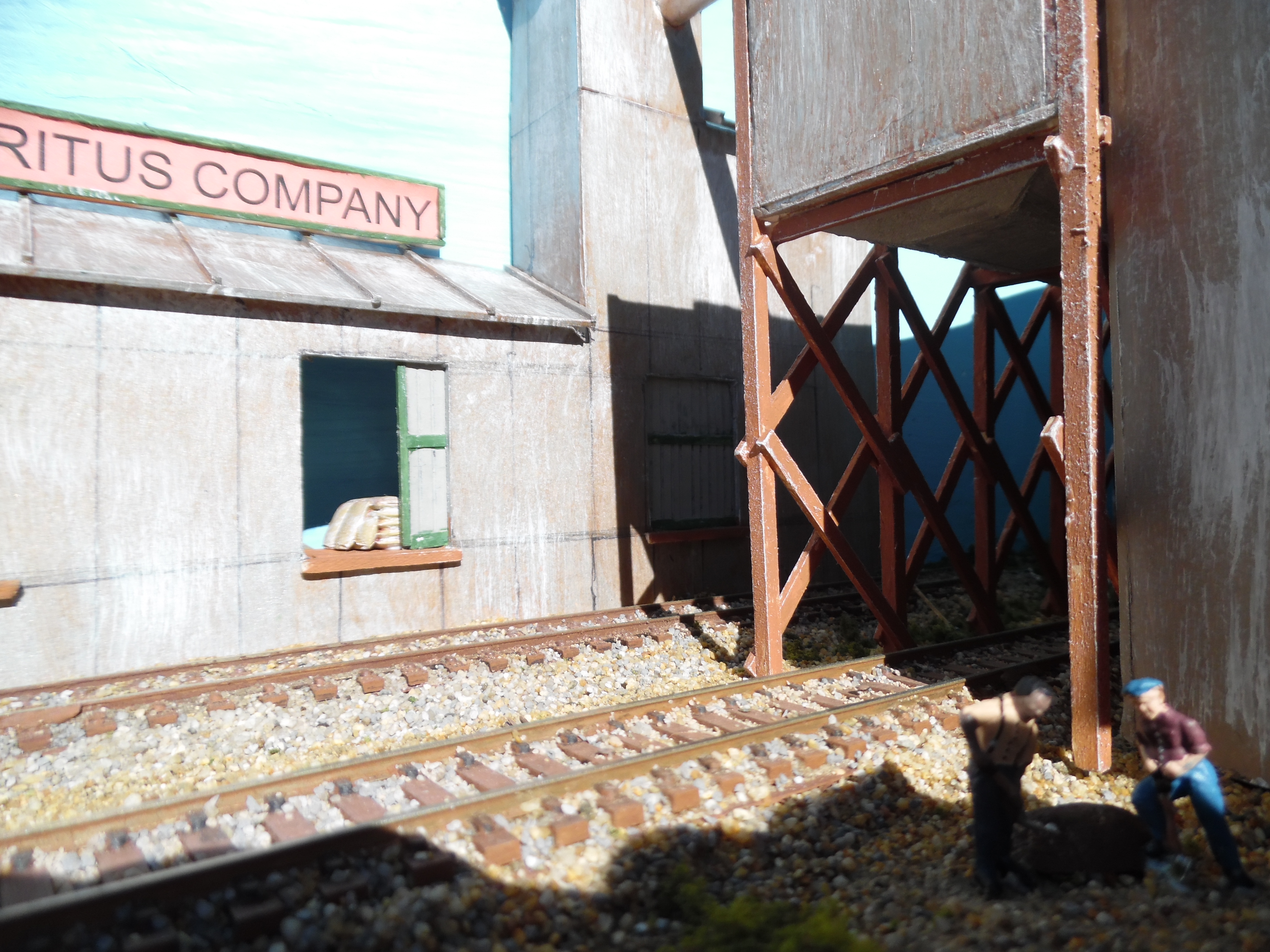
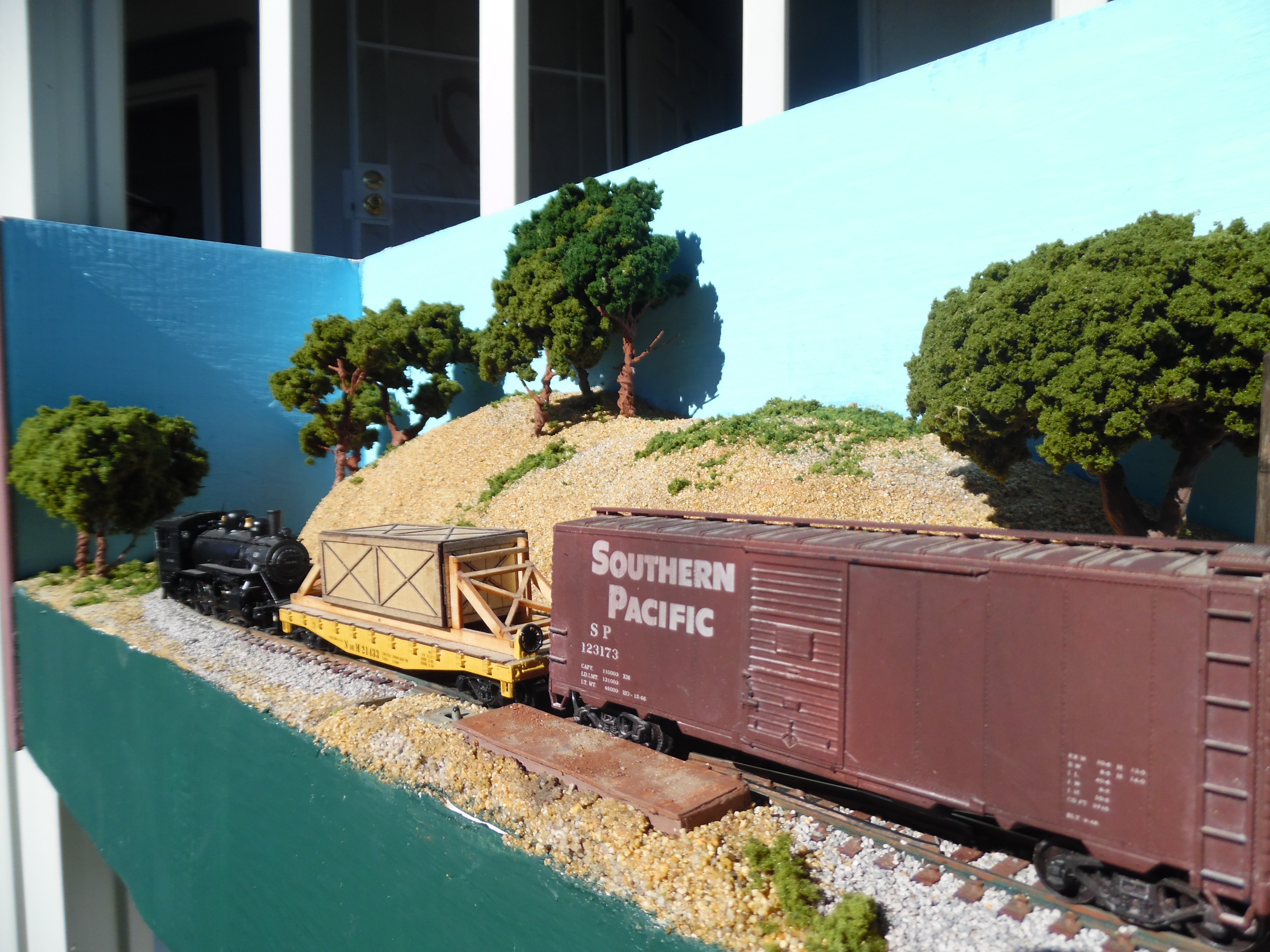
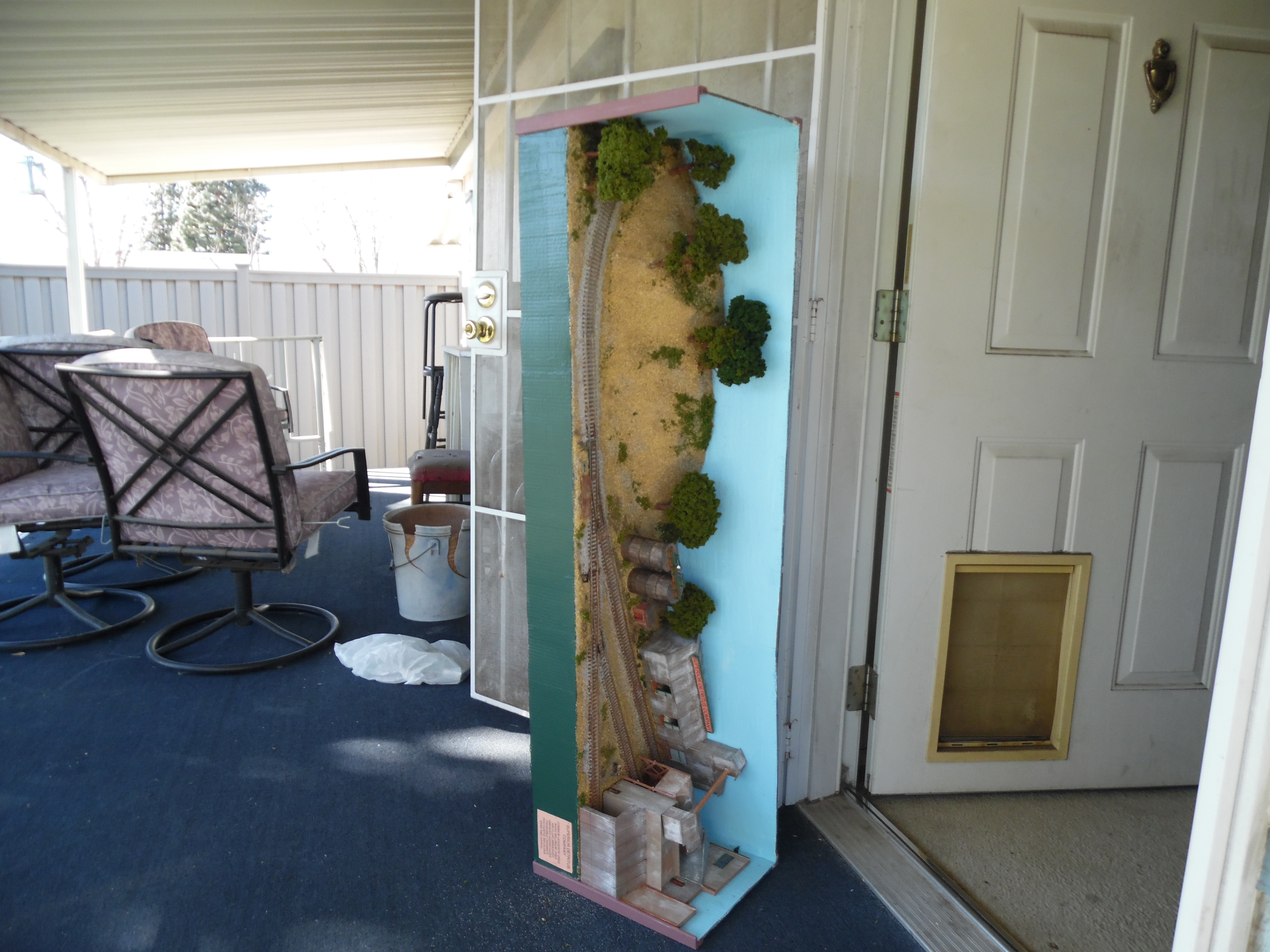



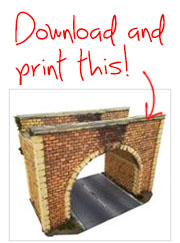
Great work by John on the Detritus layout, especially as its made from mostly cardboard. Highlights the strength of this underated material when made into a box shape, and light too, another advantage over wood.
Finished layout looks really good and shows what you can do on a limited budget.
Mike S
Absolutely fantastic, great work on a limited budget and space.
Thanks for the photies.
Willie Kerr (Glasgow)
Those trees look more like the giant redwoods…I grew up in the redwood forest in the Santa Cruz mountains of California. A section of “drag road” went through our yard. Oxen teams were used to drag the logs to the railhead and load them on the cars…
One method used, especially in the area of the Pacific North west, was the use of one or two donkey engines on sleds anchored to trees in the vacinity. Loggers would leave some very tall trees, stripped of all limbs, snd rigged with pullys and steel cables to act as lifting devices.
However here in Western Australi, suitable embankments were built next to to the rail line and logs were rolled onto the log cars or what ever. Some our giant Karri, Tingle and Jarrah trees posed huge logistcal problems, but the logging industry were very enterprising, to say the least.
Pete
Wow impressed with the cardboard used to make this scenary and buildings wish Ihad those skill . It would make modeling a lot easier and cheaper.
Absolutely marvellous, the best tip yet, I`m glad I didn`t throw out all my old boxes now, they will now be turned into a really worthwhile use, my new railway!
Keep up the good work your pictures and commentary are inspiring and has opened up a whole new project for me.
Mike
Newark England
That looks great. Just a hint.Replace the bulky switch with a under the table mini rc servo.
old pictures are of redwoods i believe as for the card board layout nice work! I got a box that a kawasaki came in it is 1/2 ” thick and moisture resistant i made a 2’x4′ module and it sat on my back patio all winter and it is still in good shape used titebond 2 water proof glue so it didn’t fall apart.
Most logging rail lines were built along streams etc because the grades were easier. They would build the roadbed a little ways up hill and gravity did much of the work. As previously mentioned oxen were the machine of the day and two man crews were dozens of men with no lawyers or insurance issues – life was cheap. The empty logging trains would back up the hill to load as they extended the rails further up hill, they cut the lower land hanging trees first. The general logging term for all of this is steep slope logging. Look up the American Logging Corp for some great historic pictures of the steam operated crane machines of the day. They had a crane that had tracks along the top of the flat cars and loaded from the last car to the engine, they removed short rail bridges between the cars and down the hill they went with their American crane in tow powered by a Shay or Climax locomotive and on to the saw mill. The grand daddy of them all was a large portable platform powered by steam with a derrick and boom cable system that operated overhead, this was previously described in this blog.
the pictures of the ‘slope logging’ are priceless ( that’s how they loaded the flatcars) the train was in a pit and the logs were rolled downhill using gravity and sometimes the ox teams mentioned….
the Detritisj layout is definately a work of art and the price is, well, also priceless!!
excellent work John
keep it runnin’
Here in the Pacific Northwest the logs were cut and then “yarded” in tandem with “Donkey Engines” to a convenient landing to be either “skidded” behind teams of oxen or horses, or loaded on log cars using a variety of equipment. Again the Donkey Engine was typically used along with a “spar tree” and a lifting apparatus like a “haymaker” which was a improvised crane off the spar tree or actual manufacturer equipment such as the McGiffert log loader to name one.
Get more info by looking online, Wikipedia, Google the early logging industry as well as the words I emphasised or your local book stores and libraries.
I grew up with a grandfather in the Washington State department of Natural Resources. I also built an N scale :monster module” that features logging. Two semi scratchbuilt yarders, logging landings, load out to rail, the scratchbuilt sawmill, etc……
Nice. And the rest of the layout?
The answer o the logging mystery depends on the era. Early logging was by oxen, horse, or mule. Logs were loaded on cars using a ramp. Later logging used steam donkey engines powering various kinds of loaders that lifted logs onto the cars. The loader mounted on rails on the log car was called a Barnhart loader. A loader using a spar tree was a haystack loader with a heel boom. Two loaders that straddled the train and loaded cars as they passed under them were the McGiffert loader and the Lidgerwood combination harder and loader. You can Google any of these to get more specific info. Of course, loggers are very inventive and there were lots of homemade solutions.
@ John .
Fantastic job!!!!!!!!
Fitz
I recommend two books for serious model logging RR’s:
Coleman, The Model Railroader’s Guide to Logging Railroads, Kalmbach Books 2008
Bryant, Logging, 1939, reprinted by NMRA, 2008
Several Photos of loading logs
logging railways are interesting.
Love the Detritis company and how they have diversified.
One thing that surprised me that is a rod style locomotive a 2-6-2 maybe ?? photo is not that sharp most used a geared one like the shay- climax or a hiesler In the US we have a couple of good tourist logging rail roads Cass scenic in West Virginia and Mt Rainier in Washington that are a nice ride .
A few responses of my own….
The logging pictures look like they might have been on the California Western just north of Fort Bragg, California. The trees are probably redwoods.
As to my little cardboard layout….
One of the goals was to keep cost as low as possible. I usually use Caboose Industries throws (S-202). In this case, the Atlas machines were “free” with the turnouts… Just the price point I was looking for.
As to the processing plant and my skill… There is a reason it took over a month and a half to build… I was building skills as I was building the structure.
John
Great Layout! It has given me some ideas for my forthcoming layout. I n ow have the excuse for collecting all sorts of stuff which my wife says is “junk” Thanks loads.
As to the question of loading logs, there are a number of answers, some already listed by others. There were a number of log loaders patented, some ran on tracks on the cars and some were high up on stilts so the cars could run underneath. It was common to leave a large tree standing near the tracks, with its branches cut off and cables were rigged, sometimes with a nearby second tree, to make a crane like structure. Back issues of Narrow Gauge Gazette often featured plans, photos and the real thing and models.
Alastair,
In answer to your logging train mystery,
The saw in the picture was a cross-cut saw also called a misery whip or whipsaw.
Cumbersome gasoline powered drag saws were developed in the late 1800s, and
lighter gasoline saws were developed in the early 1900s.
They also used Temporary horse- or mule-drawn “railroad” with
wooden tracks. Sometimes logs were used for tracks instead of
boards.
Sky-line cabling moved huge logs to landings with the whole
log suspended on cables and loaded onto trains.
Huge trees were sometimes “bucked up” (cut into
sections) with whip saws to make railroad ties, grape stakes,
shingles, or other split goods.
For history lesson try:(With same old photos)
(www.parks.ca.gov/pages/735/files/04seciihumanhistorych4and5.pdf)
Gosh, that takes me back. There was a UK TV documentary about London’s sewerage system and the guides were a couple of guys who had obviously been told by management that the polite word to use for what they would normally call s*** was ‘detritus’ but that wasn’t a word in the ordinary sewerman’s vocabulary and it got mangled into Detroits. Oops! (Go, Lions!)
Rod
there still plenty of old logging workings here in new Zealand which show how logs were dragged by oxen teams on smaller logs similar to Egyptians rolling stone blocks then dragged across or rolled down a ramp onto the wagons for their trip down to the mill these ramps were so effective that even after logs began to leave the forest by truck they continued loading this way using bulldozers to push the logs on to trucks from the ramp p.s. some of our huge kauri trees were as big around as they trees in the photo but they were not as long and would often be felled and a pit dug underneath to pitsaw the log in place then the lumber carted off in wagons hope that’s a bit of extra info that shows some nz logging keep up the good work I do enjoy hearing about others train layouts as im trying to build 1 for my 2 boys too and the hints are helpful thanks allan
Very nice workmanship, imaginative and thrifty. Thanks for sharing.
Very impressive and frugal.
The three truck Shay is my favorite steam engine. Unfortunately I model S gauge (1/64th scale). Have you or anyone out there ever seen a Shay in that scale? I would build a logging operation just to model one!
In relation to logging trains, all the descriptions are accurate except for the Copeville operation. That one was on a mountain without water features. That operation used Shays and a switch back rail set-up. The Shay would head up from the town yard and go through a series of switchbacks to reach the logging site high on the mountain. Loading was done the way Pete described above. Of course, the logs harvested were mostly pine so it wasn’t quite as dangerous as the redwood operation pictured.
Adding here just a memory from childhood (about 1950) when we lived in Longview, WA. One day we were behind a large flatbed log truck as we drove back to our
home. What was memorable was the fact the truck had only one log chained to the
flat bed. It was enormous. The flat bed itself was 8ft across but the overhang of the
log was easily 1ft on each side. The log being on the flatbed was high enough so that oncoming traffic would actually pass under a portion of the overhang. As a
youngster I couldn’t figure out why the truck didn’t just tip over. The truck was
passing the smaller sawmills so was apparently heading to either Long-Bell Lumber Company or Weyerhaeuser which were both situated next to the Columbia River.
Great job man! I really like small switching layouts. I’ll be starting one soon.
Most likely that is a Redwood tree for they got that big a doug fir does not get that big. They used Spar trees that could be 100 or more feet tall.Many redwoods were over 200 feet tall. I have seen pictures with 30 or more people around a trunk of a tree. There are pictures of people making a house in one of the stumps from those trees. I would like one that way. My logging railroad is in the final planning stages now.
Doug fir trees can be fairly tall at 200 ft but only 6 feet in diameter. Some redwoods were over 375 feet and over 20 feet in diameter. they are the oldest living things in this world. Some were recorded at over 2000 years.
Beautiful work. Others contemplating a cardboard layout might also contemplate the effects of humidity over time. It’s unlikely to be very stable and could lead to track issues.
Loved the train with the logs. Work with a friend at his sawmill, he had a large collection of photos with even bigger trees if you can believe it. I wonder HOW they sawed the log up into boards. Get them off the train on to the mill. I still have my Peevey.
I fell in love with logging railroads in 1962 when we toured a sawmill in Klamath Falls, Oregon and I saw my first Climax geared locomotive (on display in a park in front of the sawmill.) Timber Times magazine has a lot of information and photos about the early and current logging industry and how to model it. Unfortunately, they are apparently out of print now and selling for about $10 – $20 an issue on eBay. (They originally sold for less than $5 per issue and I have issues #1 through 41.)
John, I loved your cheap layout tutorial. I guess I should have been saving all those big cardboard boxes I’ve taken to the recycling center recently. Thanks for sharing your ideas and memories of John Allen (one of my and many other model railroader’s heroes.) I met John in 1962 on that same trip to the Seattle World’s Fair and got to run a train on the Gorre & Daphetid. I was 14 years old and that was the highlight of the trip.
They most probably had some sort of loading area set up for then since these were not a singular occurrence. My thoughts run to how did they get the logs to the landing.
Great job, but you left out the punch line. How did you finish the buildings and tanks? Is it paint? I see lines indicating siding.
While the layout/diorama is small, I find myself looking at it over and over again. The story is quite interesting too. We’ve all learned something here!
Hey John, Great job! I’d like to recommend the book TUMULT ON THE MOUNTAINS by Roy Clarkson. It’s about the lumber industry in WV, 1800s to early 1900s. Lots of photos. Keep up the good work!
In the early 1900’s in the Pacific Northwest, some of the tallest and widest trees were the Doug Firs. The tallest Washington Doug Fir trees ever measured were likely taller than the tallest known living redwood. Some may actually have been over 400 feet high, and these trees would have been about fifteen feet wide. All the biggest, oldest ones were cut down, but some giants still survive.
How do you get the train to run without a connection
Seeing your layout is very inspiring and encouraging. Thanks for sharing. I felt is sad that those super large trees would never be replaced once they were cut down.